Parts Of a Sail Explained (Illustrated Beginners Guide)
Are you curious about sail mechanics and how they engage the wind? In this illustrated guide, we'll explain the various sail components and how they work together to propel a sailboat. From the head to the foot, the tack to the clew, we'll break down each part and give you a solid foundation to build on as you learn to trim sails and navigate the open sea.
A sail, which is a large piece of fabric that is attached to a long pole called the mast, uses the wind to pull a sailboat across the water. It has various parts, such as the head, tack, clew, luff, leech, foot, mainsail, jib, and batten. These components determine the shape and efficiency of the sail.
Let's break down all these terms and descriptions to understand how each component interacts with each other. So, whether you're a seasoned sailor or a beginner, you'll have a better grasp of sail trim and optimal performance on the water.
- The primary parts of a mainsail include the head, tack, clew, luff, leech, and foot.
- Some critical elements of the jib include the sheet, genoa, and headstay.
- Asymmetrical spinnakers are designed for off-wind sailing and have a more rounded shape, while symmetrical spinnakers are used for downwind sailing and have a more traditional, triangular shape.
- The most common fabrics used for making sails are traditional fabrics like cotton and flax, and modern fabrics such as polyester and nylon, Dacron, Mylar, and laminates.
- Be sure to learn how to properly trim, reef, clean, flake, and store your sails for durability and optimal performance.
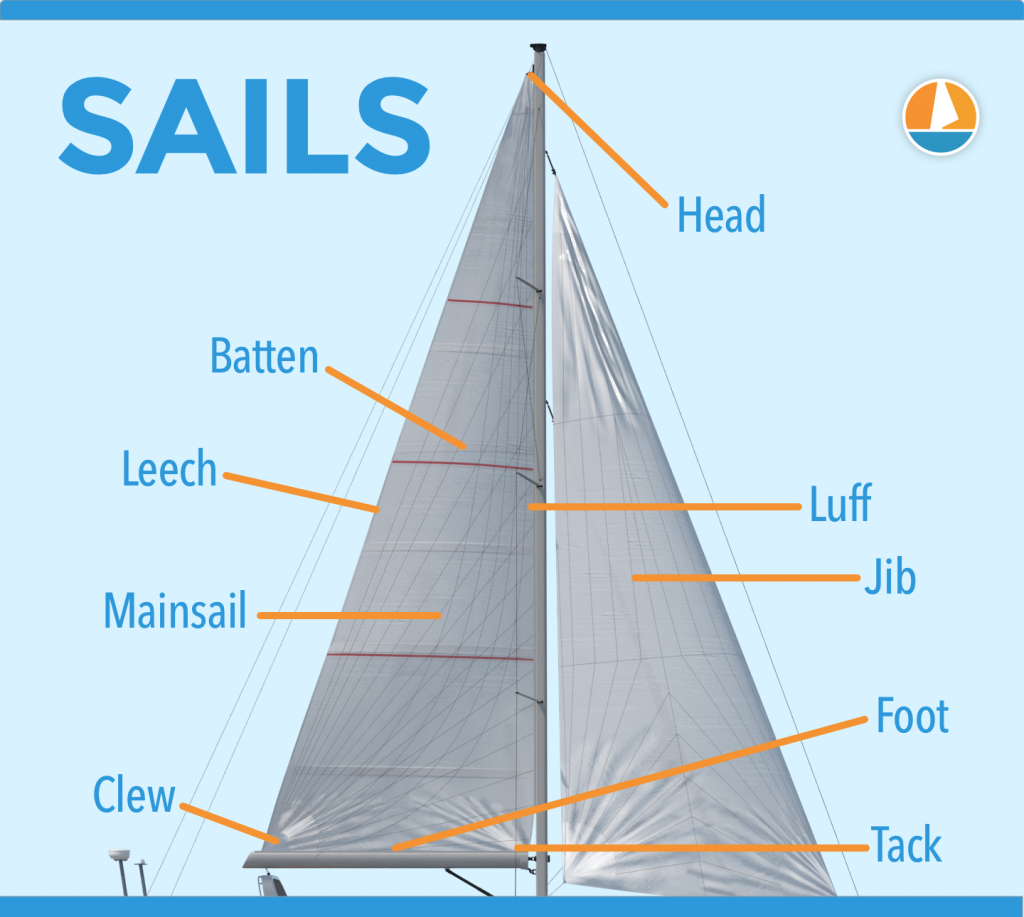

On this page:
Parts of a sail and their functions, mainsail components, jib components of a sailboat, components of spinnakers, sail controls and settings, sail care and maintenance, sail materials and construction.
In this guide, we'll focus on the three main types of sails : Mainsail, Jib, and Spinnaker.
Mainsail is the primary sail on your boat
The mainsail is the largest sail on a sailboat and is typically attached to the mast and boom. It is found aft (rear) of the mast. It's attached to the boat through a track or sail slide, which allows it to move up and down.
| Description | |
|---|---|
| the very top of the sail that is attached to the mast | |
| the bottom edge of the sail that is attached to the boom | |
| the front, leading edge of the sail that runs along the mast | |
| the trailing edge of the sail that runs from the head to the clew | |
| the bottom front corner of the sail | |
| the bottom aft corner of the sail that is attached to the boom | |
| are thin, flat strips of material (such as fiberglass or wood) that are inserted into pockets in the sail to help it maintain its shape and prevent it from flapping in the wind | |
| are sets of small lines or ties that are used to reduce the size of the sail in high winds | |
| are small pieces of ribbon or yarn that are attached to the sail to help the sailor determine the direction and strength of the wind | |
| are numbers that are affixed to the sail to identify the boat in racing situations | |
| include lines or sheets that are used to control the shape and position of the sail, such as the mainsheet, outhaul, and cunningham |
Jib is a triangular sail placed in front of the boat
The jib is a smaller sail that is attached to the bow of the boat and works in conjunction with the mainsail to control the direction and speed of the boat. It helps to improve the boat's handling and increase speed, working in tandem with the mainsail.
| Description | |
|---|---|
| the top of the sail that is attached to the forestay | |
| the leading edge of the sail that runs along the forestay | |
| the bottom edge of the sail that is attached to the deck or a furling drum | |
| the trailing edge of the sail that runs from the head to the clew | |
| the corner of the sail that is attached to the deck or a furling drum | |
| are small pieces of ribbon or yarn that are attached to the sail to help the sailor determine the direction and strength of the wind | |
| are lines that are used to control the position and trim of the sail | |
| a device that allows the jib to be rolled up and stored when not in use | |
| are clips that are used to attach the jib to the forestay on boats that do not have a furling drum | |
| the bottom forward corner of the jib that is attached to the boat's bow |
In some cases, larger jibs called genoas are used to capture more wind, thus increasing the boat's speed.
Spinnaker is designed for sailing downwind
The spinnaker is a large, colorful, and lightweight balloon-shaped sail designed for sailing downwind. It captures the wind from the rear, pushing the boat forward with added speed and stability.
| Description | |
|---|---|
| the top of the sail that is attached to a spinnaker halyard | |
| the leading edge of the sail that runs along the spinnaker pole | |
| the bottom edge of the sail that is attached to the spinnaker tack line | |
| the trailing edge of the sail that runs from the head to the clew | |
| the corner of the sail that is attached to the spinnaker sheet | |
| a long, horizontal pole that is attached to the mast and used to hold the spinnaker out from the boat | |
| a line that is attached to the spinnaker pole and used to control its position | |
| a line that is attached to the clew of the spinnaker and used to control its position and trim | |
| a line that is attached to the lower forward corner of the spinnaker and used to control its position | |
| a device that is used to control the spinnaker when it is being raised or lowered |
In this section, you'll find a comprehensive explanation of the primary components of a sail and their functions:
Head is the uppermost corner of a sail
The head of the sail refers to the uppermost corner where it connects to the top of the mast. Knowing the location of the head is essential, as it helps you identify the top of the sail and allows you to properly hoist and secure it in place.
Tack is the lower front corner of a sail
The tack is where the lower front corner connects to the base of the mast, or the boom. This important point helps you determine the sail's orientation and affects its overall shape and efficiency. By adjusting the tension at the tack, you can control your sail's performance and handling in various wind conditions.
Clew is the lower rear corner of a saisl
The clew is where the sheets attach to control the sail's angle to the wind. Adjusting the tension on the sheets can change the sail's shape and ultimately influence the boat's speed and direction. Becoming familiar with the clew will help improve your sailing skills and ensure smooth maneuvers on the water.
Luff is the front edge of the sail
The luff is the forward edge of the sail that runs along the mast. It's crucial to maintaining a tight and efficient sail shape. When sailing upwind, pay close attention to the luff, as it can provide valuable information about your sail's trim. A properly trimmed sail will have a smooth luff, allowing the boat to move efficiently against the wind.
Leech is the rear edge of the sail
The leech is opposite the luff. It plays a critical role in controlling the overall shape and efficiency of your sail. Watch the leech carefully while sailing, as excessive tension or looseness can negatively affect your sail's performance. Adjusting your sail's trim or using a device called a "boom vang" can help control the shape and tension of the leech.
Foot is the bottom edge of the sail
The foot is running between the tack and the clew. It helps control the shape and power of the sail by adjusting the tension along the boom. Ensure the foot is properly trimmed, as this can impact your boat's performance and speed. A well-adjusted foot helps your sail maintain its proper shape and operate at optimal efficiency while out on the water.
In this section, we'll look at some critical elements of the jib: the sheet, genoa, and headstay.
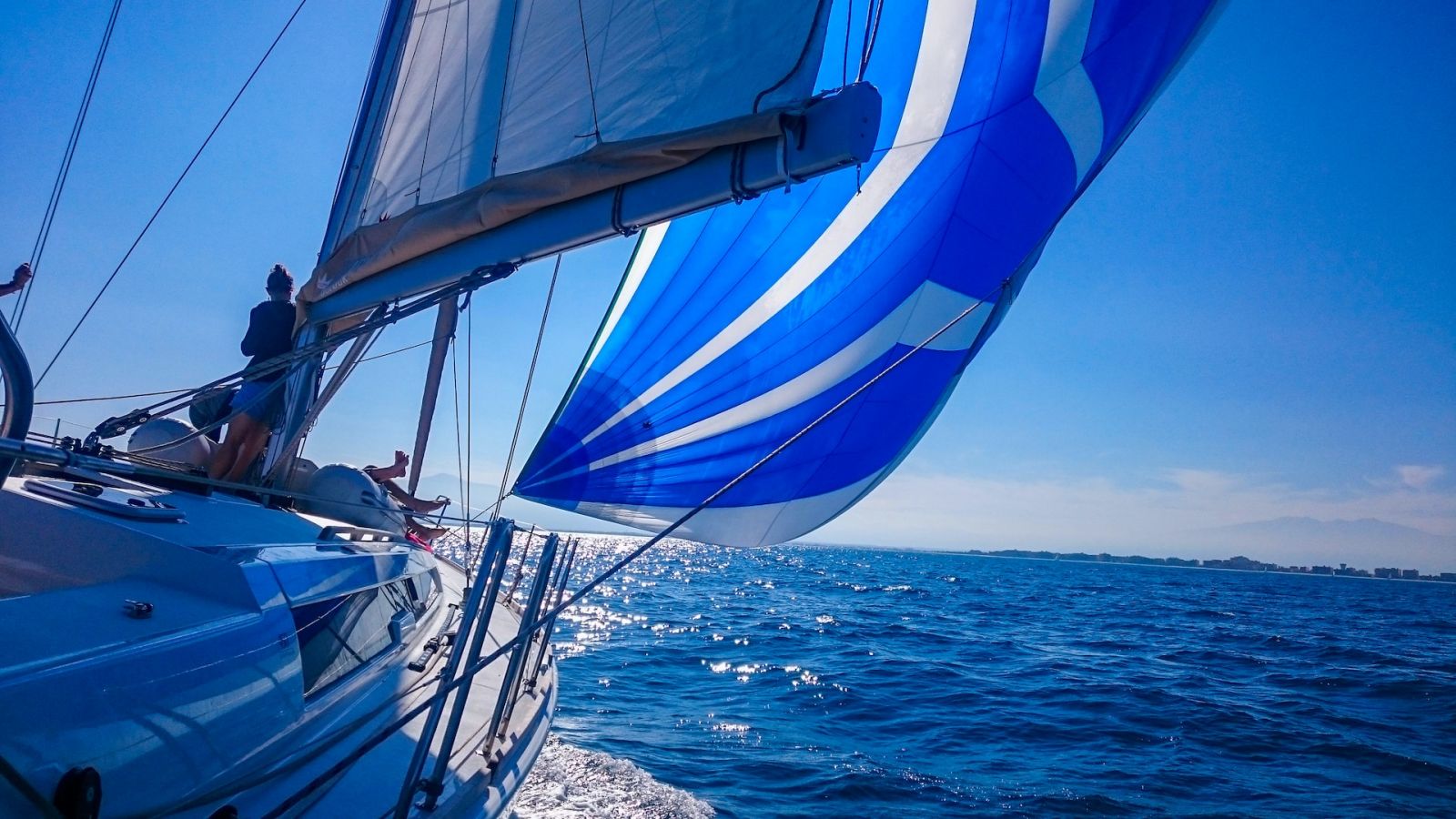
Sheet is the line used to control the position and trim of the sail
The jib sheet is the line used to control the jib's angle in relation to the wind. You adjust the sheet to get the best possible sail trim, which greatly affects your boat's performance. The jib sheet typically runs from the jib's clew (the lower rear corner of the sail) through a block on the boat's deck, and back to the cockpit, where you can easily control it.
When adjusting the jib sheet, you want to find the perfect balance between letting the sail out too far, causing it to luff (flutter), and pulling it in too tightly, which can cause heeling or poor sail shape. Make small adjustments and observe how your boat responds to find the sweet spot.
Genoa is a larger jib used to capture more wind
A genoa is a larger version of a standard jib. It overlaps the mainsail, extending further aft, and provides a greater sail area for improved upwind performance. Genoas are categorized by the percentage of overlap with the mainsail. For example, a 130% genoa means that the sail's area is 30% larger than the area of a jib that would end at the mast.
Genoas are useful in light wind conditions, as their larger surface area helps your boat move faster. However, they can become difficult to manage in strong winds. You might need to reef (reduce the size) or swap to a smaller jib to maintain control.
Headstay provides a support structure for the jib
The headstay is a crucial part of your boat's standing rigging system. It is the cable or rod that connects the top of the mast (the masthead) to the bow of the boat. The headstay helps maintain the mast's stability and provides a support structure for the jib.
The tension in your headstay plays a significant role in the jib's sail shape. Proper headstay tension will create a smooth, even curve, allowing your jib to perform optimally. If the headstay is too tight, the sail may be too flat, reducing its power, whereas a loose headstay can result in a sagging, inefficient sail shape.
A spinnaker is a sail designed specifically for sailing off the wind , on courses between a reach and downwind. They are made of lightweight fabric, often brightly colored, and help maximize your sailing speed and performance.
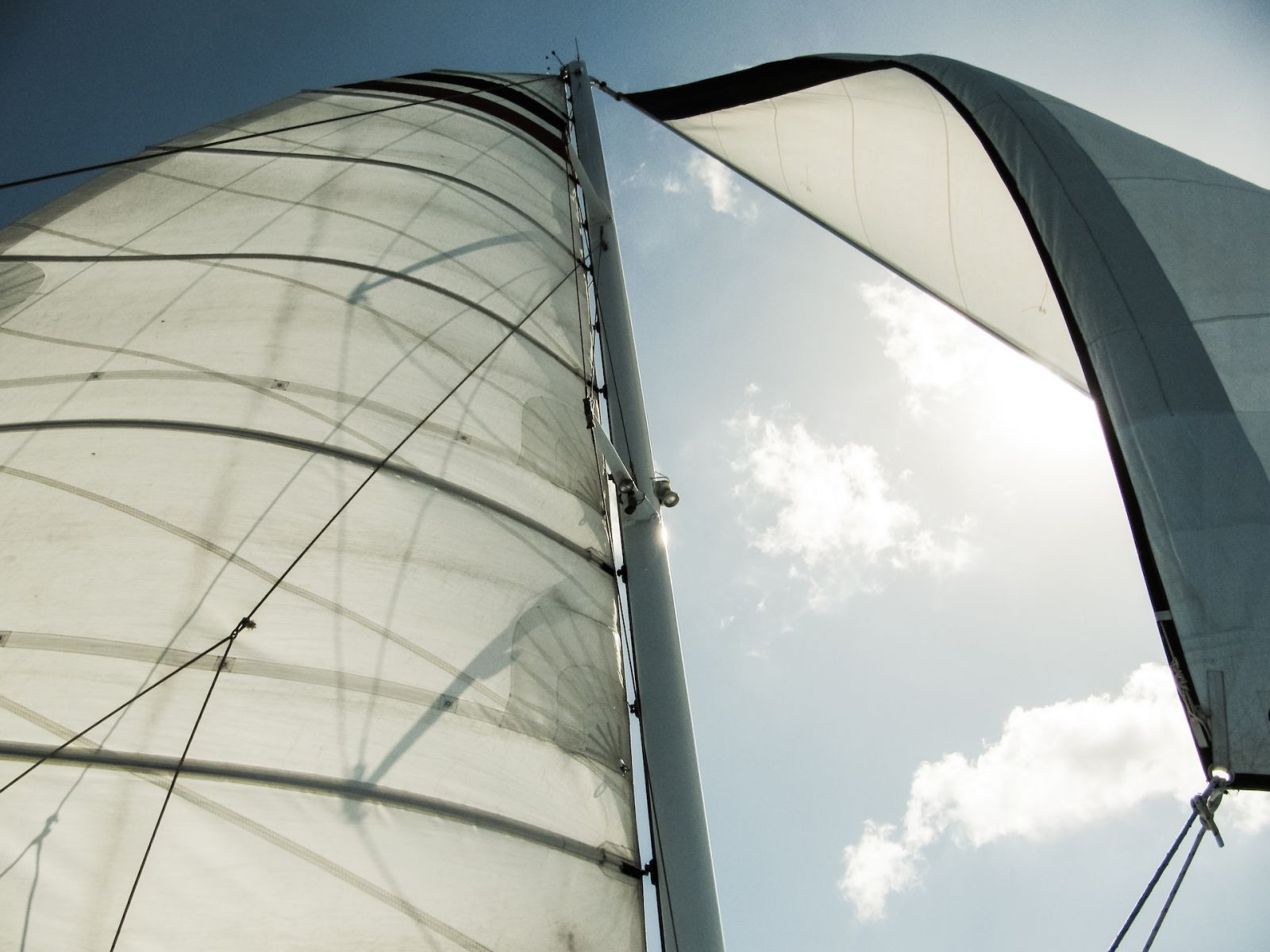
Asymmetrical spinnakers are designed for off-wind sailing
Asymmetrical spinnakers are usually found on modern cruising and racing boats. They're designed for a broader range of wind angles and have a more forgiving shape, making them easier for you to handle. Key components of an asymmetrical spinnaker include:
- Tack : This is the front, lower corner where the sail connects to the boat. A tack line is used to adjust the sail's position relative to the bow.
- Head : The top corner of the sail, where it connects to the halyard to be hoisted up the mast.
- Clew : The aft corner of the sail, connected to the sheet, allowing you to control the angle of the sail to catch the wind effectively.
You can find a step-by-step guide on how to rig and hoist an asymmetrical spinnaker here .
Symmetrical spinnakers are used for downwind sailing
Symmetrical spinnakers are more traditional and usually found on racing boats, where downwind performance is critical. These sails are shaped like a large parachute and are split into two identical halves. Key components of a symmetrical spinnaker include:
- Head : Similar to the asymmetrical spinnaker, the head is the top corner connected to the halyard.
- Clews : Unlike an asymmetrical spinnaker, a symmetrical spinnaker has two clews. Both are connected to sheets and guys, which help control the sail's shape and movement.
- Spinnaker Pole : This is a horizontal pole that extends from the mast and is used to project the windward clew outwards and hold the sail open.
Handling a symmetrical spinnaker can be more challenging, as it requires precise teamwork and coordination. If you're new to sailing with this type of sail, don't hesitate to seek guidance from experienced sailors to improve your technique.
In this section, we'll explore sail controls and settings, which are essential for beginners to understand for efficient sailing. We'll discuss trimming, and reefing, as sub-sections.
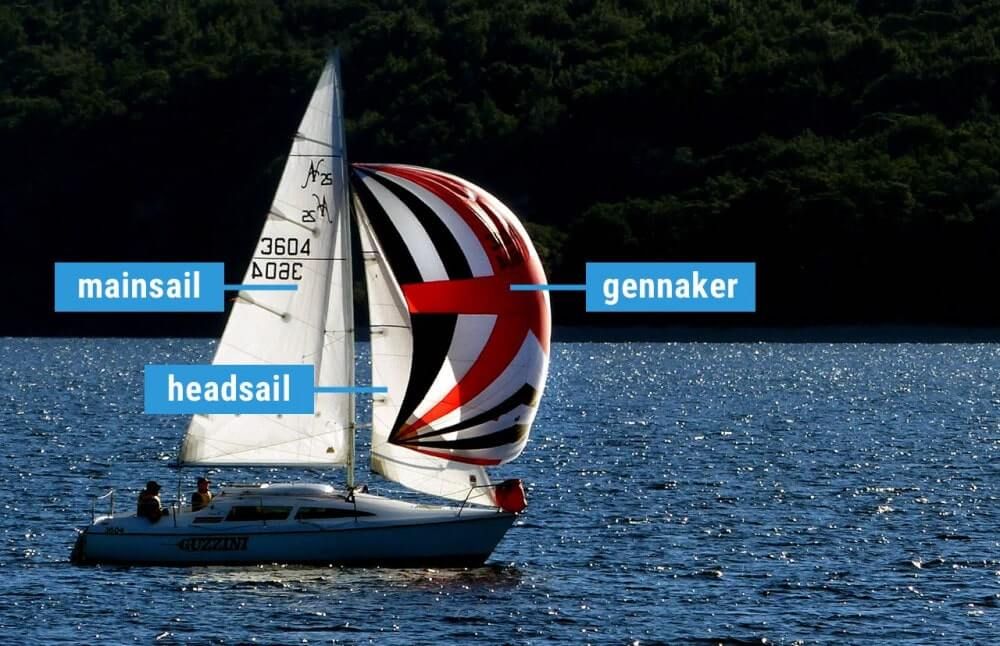
Trimming your sails for speed and stability
Trimming is the process of adjusting your sails to optimize them for the current wind conditions and desired direction. Proper sail trim is crucial for maximizing your boat's speed and stability. Here are some basic tips for sail trimming:
- Pay attention to the telltales, which are small ribbons or yarn attached to the sails. They help you understand the airflow over your sails and indicate whether they're properly trimmed.
- Use the sheets, which are lines attached to the clew of your sails, to adjust the angle of your sails relative to the wind.
- In light winds, ease the sails slightly to create a more rounded shape for better lift. In stronger winds, flatten the sails to reduce drag and prevent excessive heeling.
Reefing your sails for control and balance
Reefing is the process of reducing the sail area to help maintain control and balance in stronger wind conditions. It's an essential skill to learn for your safety and the longevity of your sails. Follow these steps to reef your sails:
- Head into the wind to reduce pressure on the sails.
- Lower the halyard (the line that raises the sail) until the sail reaches the desired reefing point.
- Attach the sail's reefing cringle (reinforced eyelet) to the reefing hook or tack line.
- Tighten the new, lower clew (bottom corner) of the sail to the boom with the reef line.
- Raise the halyard back up to tension the reduced sail.
Take proper care of your sailboat to ensure that it remains in top condition. In this section, we will discuss the key aspects of sail care and maintenance, focusing on cleaning and storage.
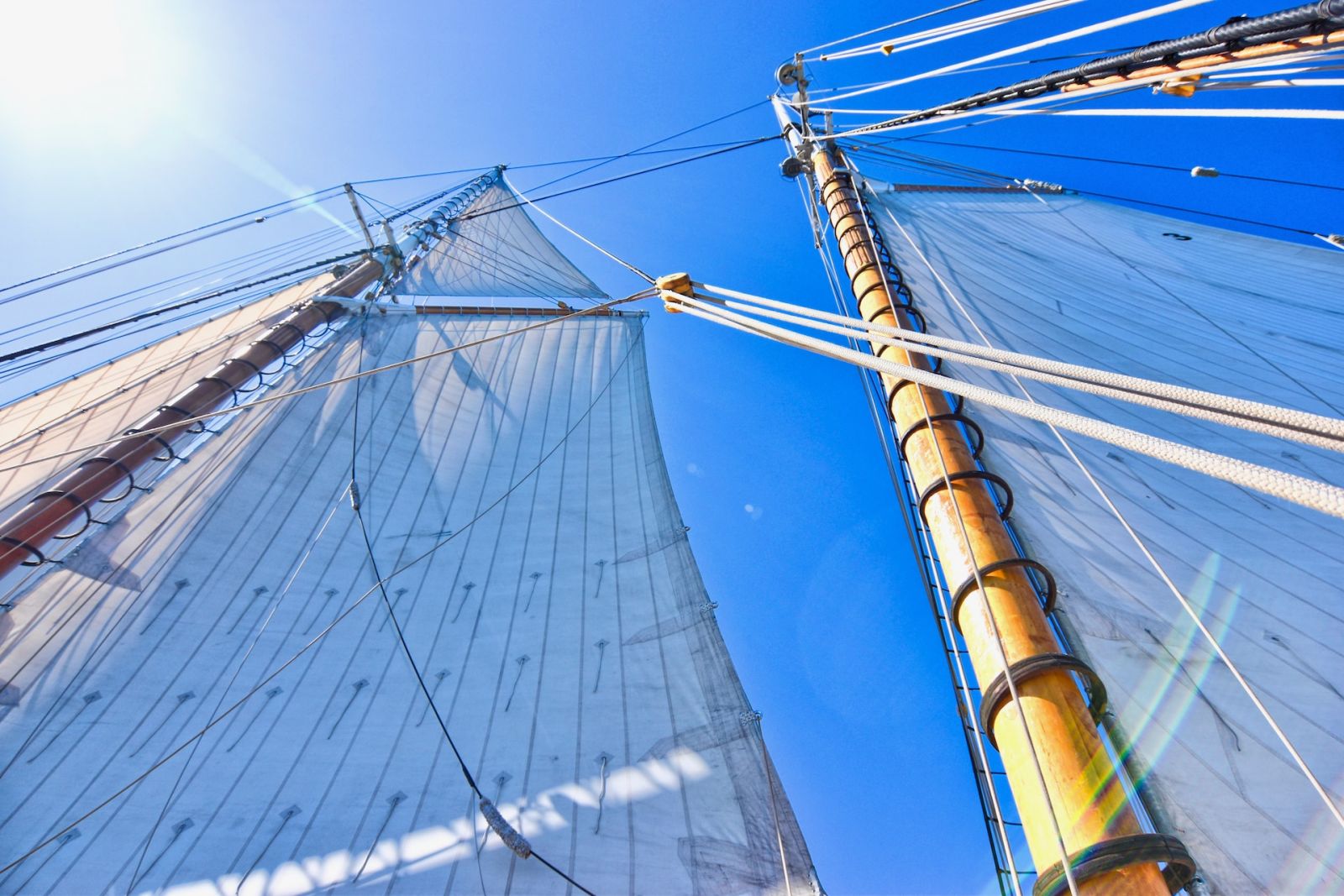
Steps to clean your sails
Keeping your sail clean is crucial for its longevity and performance. Follow these simple steps to maintain a spotless sail:
- Rinse with fresh water after each use, paying extra attention to areas affected by saltwater, debris, and bird droppings.
- Use a soft-bristled brush and a mild detergent to gently scrub away dirt and stains. Avoid harsh chemicals or abrasive materials, as they may damage the fabric.
- Rinse again thoroughly, ensuring all soap is washed away.
- Spread your sail out to air-dry, avoiding direct sunlight, which may harm the fabric's UV protection.
Ways to store your sails
Sail storage is equally important for preserving the lifespan of your sail. Here are some tips for proper sail storage:
- Fold or roll your sail : Avoid stuffing or crumpling your sail; instead, gently fold or roll it to minimize creases and wear on the fabric.
- Protect from UV rays : UV exposure can significantly reduce the life of your sail. Store it in a cool, shaded area or use a UV-resistant sail cover when not in use.
- Ventilation : Ensure your sail is stored in a well-ventilated area to prevent mildew and stale odors.
- Lay flat or hang : If space allows, store your sail laid out flat or hanging vertically to reduce the risk of creasing and fabric damage.
Flaking your sails when not in use
Flaking is the process of neatly folding your sails when they're not in use, either on the boom or deck. This helps protect your sails from damage and prolongs their lifespan. Here's how to flake your sails:
- Lower the sail slowly, using the halyard while keeping some tension on it.
- As the sail comes down, gather and fold the sail material in an accordion-like pattern on top of the boom or deck.
- Secure the flaked sail with sail ties or a sail cover to prevent it from coming undone.
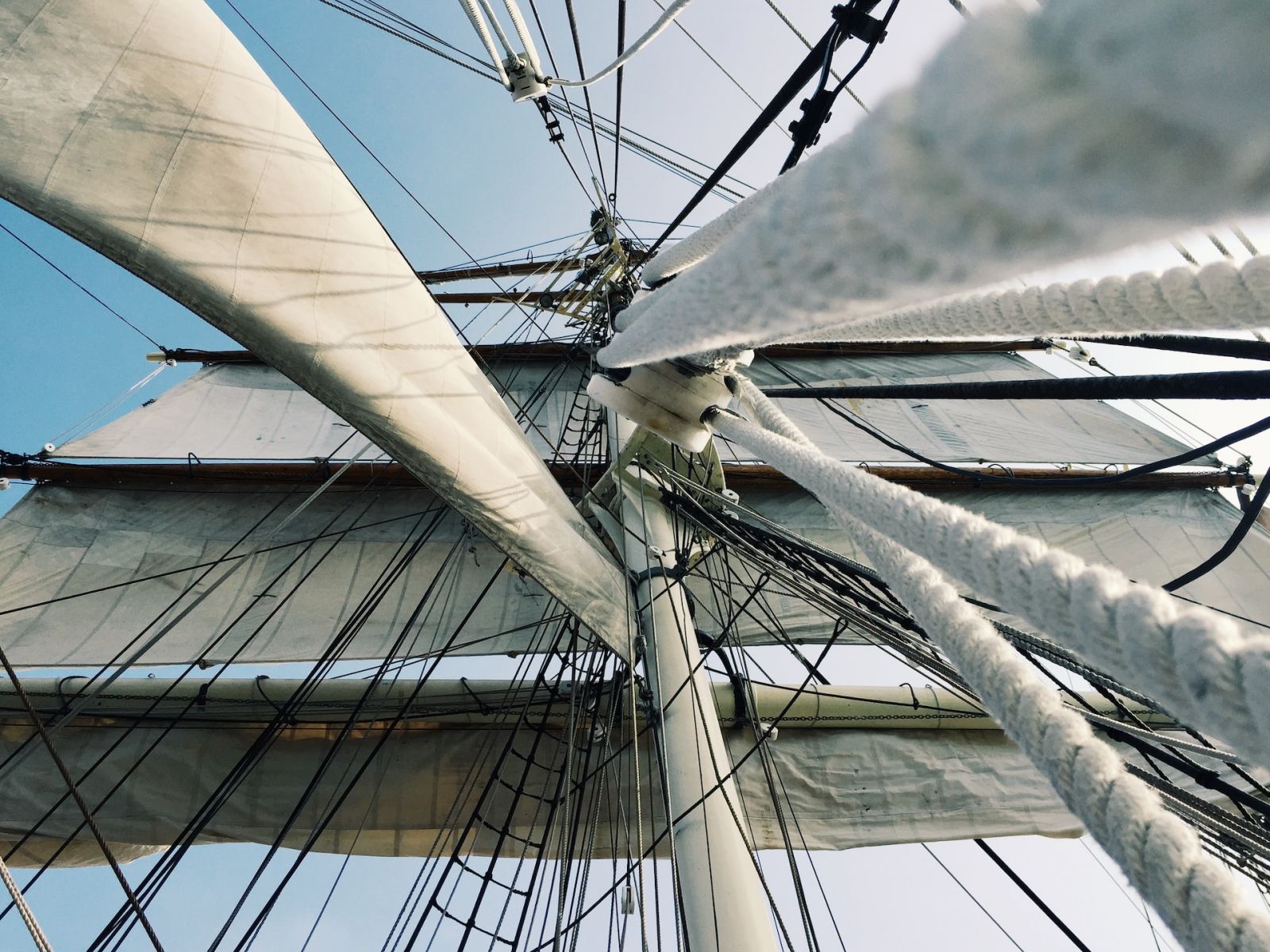
Traditional fabrics used to make sails
In the early days of sailing, natural materials like cotton and flax were used to make sails. These fabrics were durable, breathable, and held up well in various weather conditions. However, they would eventually wear out and lose their shape due to the constant exposure to UV rays and seawater.
While traditional fabrics like cotton and flax were once commonly used for sailmaking, they have largely been replaced by synthetic materials like polyester and nylon due to their superior strength, durability, and resistance to mildew and rot. However, some sailors and sailmakers still use cotton and other natural fibers for certain applications, such as traditional sailmaking or historical recreations.
Modern fabrics used to make sails
Modern sail materials, such as Dacron, Mylar, and laminates, are more resilient and longer-lasting than traditional fabrics. These materials are lightweight, strong, and resistant to UV rays and water damage.
Dacron : Dacron is a popular material for sails because of its durability, UV resistance, and ease of maintenance. It's a type of polyester fabric that is often used for making cruising sails. Dacron offers excellent shape retention and resistance to stretch, making it ideal for both beginners and experienced sailors.
Laminate materials : Laminate sails are made by bonding multiple layers of materials like Mylar, polyester, and Kevlar. These sails offer better shape and performance compared to their fabric counterparts, making them popular among racers. However, they tend to be more delicate and may not be suitable for long-term cruising.
Mylar films : Mylar films are used in laminate sails for their excellent strength-to-weight ratio and shape retention. These films are often sandwiched between other materials, such as polyester or Kevlar, to enhance the sail's resistance to stretch and load handling. However, Mylar sails can be susceptible to delamination and abrasion, requiring extra care and regular inspection.
Sail stitching for shape and durability
Sail stitching is an essential aspect of sail construction, helping to maintain the sail's shape and durability. Various stitching techniques can be used, such as zigzag, straight, and triple-step sewing. The choice of stitching type depends on the sail's purpose and expected loads. In addition, using UV-resistant thread ensures that the stitching lasts longer under harsh sun exposure.
Leave a comment
You may also like, how do sails actually work: full beginners guide.
The sails are your boat's primary driving force. Your boat is designed to sail , and with good wind it will be faster and more comfortable than using the engine. …
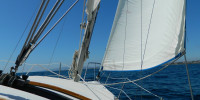
Sail Names: Explained for Beginners (With 15 Examples)
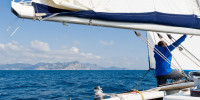
How To Trim Sails: The Ultimate Guide (with Cheat Sheet)

How To Reef Your Sails (Mainsail, Jib, Furling, Loose)

How Much Do New Sails Cost?
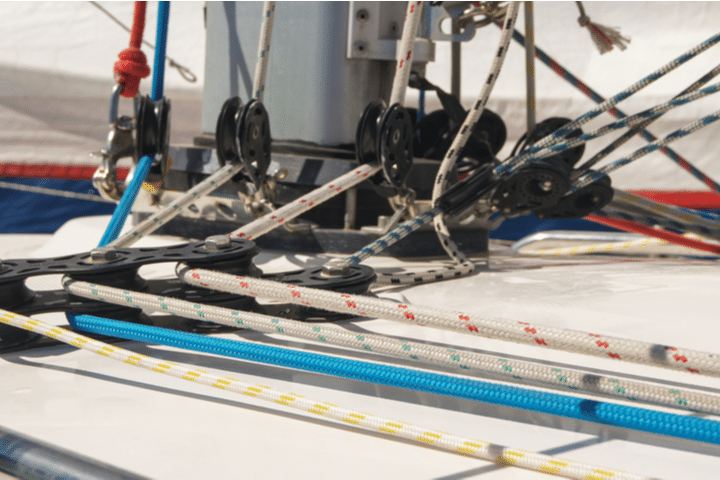
A Guide to the Different Parts of a Sailboat

Table of Contents
Last Updated on November 29, 2023 by Boatsetter Team
When you use Boatsetter, you have the opportunity to choose from a myriad of different sailboat rentals from all over the United States and beyond . A sailboat is a perfect way to relax on the water, either on a solo adventure or on an excursion with friends and family.
When you rent a sailboat with Boatsetter, you will have the option to book a captained sailboat to enjoy your day out on the water or book bareboat to hone your sailing skills. Either way, you may be interested in the intricacies of a sailboat and its different parts. If this sounds like you, you have come to the right place. In this article, we go in-depth about the different parts of a sailboat so that you can be more knowledgeable about whatever boat you may choose and come away from reading this feeling more confident about the whole sailing experience.
A basic sailboat is composed of at least 12 parts: the hull , the keel , the rudder , the mast, the mainsail, the boom, the kicking strap (boom vang), the topping lift, the jib, the spinnaker, the genoa, the backstay, and the forestay. Read all the way through for the definition of each sailboat part and to know how they work.
Explore sailboats for rent near you or wherever you want to go
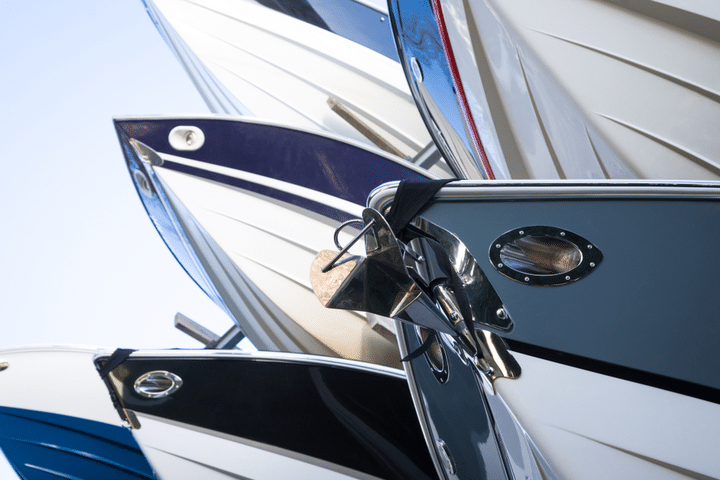
In short, the hull is the watertight body of the ship or boat. There are different types of hulls that a sailboat may have, and these different hulls will often affect the speed and stability of the boat.
Displacement Hulls
Most sailboats have displacement hulls , like round bottom hulls, which move through the water by pushing water aside and are designed to cut through the water with very little propulsion. The reason these are called displacement hulls is that if you lower the boat into the water, some of the water moves out of the way to adjust for the boat, and if you could weigh the displayed water, you would find that it equals the weight of the boat, and that weight is the boat’s displacement. One thing to know about displacement hulls is that boats with these hulls are usually limited to slower speeds.
Planing Hull
Another type of hull is a planing hull. These hulls are designed to rise and glide on top of the water when enough power is supplied. When there is not enough power behind the boat, these boats often act as displacement hulls, such as when a boat is at rest. However, they climb to the surface of the water as they begin to move faster. Unlike the round bottom displacement hulls, these planing hulls will often have flat or v-shaped bottoms. These are very common with motor-driven water vessels, such as pontoon boats, but they can also be found on smaller sailboats which allow them to glide quickly over the water.
Finally, sailboats can differ depending on the number of hulls that they have. There are three options: monohulls (one hull), catamarans (two hulls), and trimarans (three hulls).
Monohulls , which have only a single hull, will usually be the typical round bottom displacement hull or occasionally the flat bottomed or v-shaped planning hull. Catamarans have two hulls with a deck or a trampoline in between, with the extra hulls providing increased stability. Finally, trimarans have three hulls — a main hull in the middle and two side hulls used for stability. These trimarans have gained popularity because of their excellent stability and ability to go at high speeds.
When evaluating a sailboat , it is important to pay attention to the type of hull that the boat has because the type of hull a sailboat has can drastically change the sailing experience, especially when it comes to stability and speed.
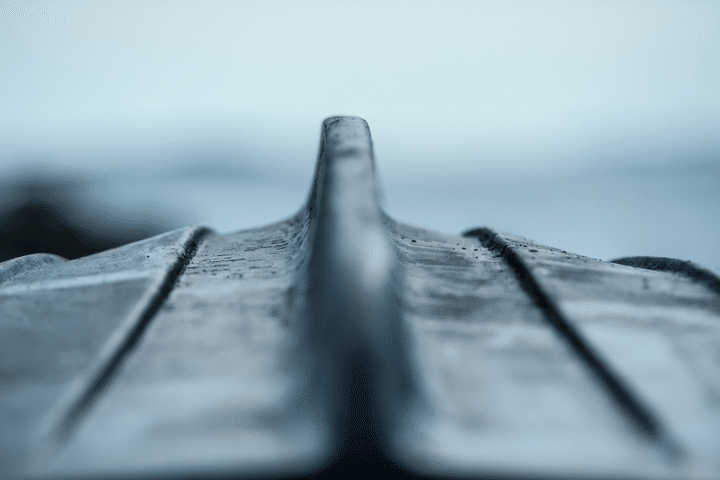
All sailboats have a keel, a flat blade sticking down into the water from the sailboat’s hull bottom. It has several functions: it provides counterbalance, life, controls sideways movement, holds the boat’s ballast , and helps prevent the boat from capsizing. When a boat leans from one side to the other, the keel and its ballast counteract the movement and prevent the boat from completely tipping over.
As with hulls, there are a number of different types of keels, though the two most common types of keels on recreational sailboats are the full keel or the fin keel. A full keel is larger than a fin keel and is much more stable. The full keel is generally half or more of the length of the sailboat. However, it is much slower than the fin keel. A fin keel, which is smaller than the full keel, offers less water resistance and therefore affords higher speeds.
A more recent feature on sailboats is the “winged keel,” which is short and shallow but carries a lot of weight in two “wings” that run sideways from the keel’s main part. Another more recent invention in sailing is the concept of the canting keels, which are designed to move the weight at the bottom of the sailboat to the upwind side. This invention allows the boat to carry more sails.
The Rudder
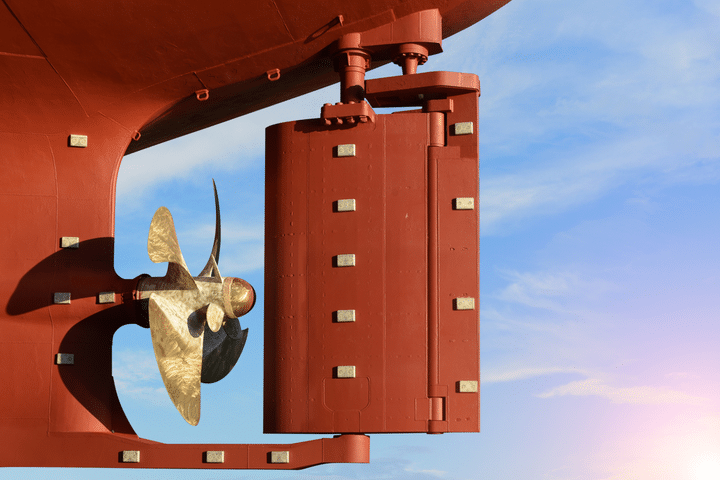
A rudder is the primary control surface used to steer a sailboat. A rudder is a vertical blade that is either attached to the flat surface of the boat’s stern (the back of the boat) or under the boat. The rudder works by deflecting water flow. When the person steering the boat turns the rudder, the water strikes it with increased force on one side and decreased force on the other, turning the boat in the direction of lower pressure.
On most smaller sailboats, the helmsman — the person steering the boat — uses a “ tiller ” to turn the rudder. The “tiller” is a stick made of wood or some type of metal attached to the top of the rudder. However, larger boats will generally use a wheel to steer the rudder since it provides greater leverage for turning the rudder, necessary for larger boats’ weight and water resistance.
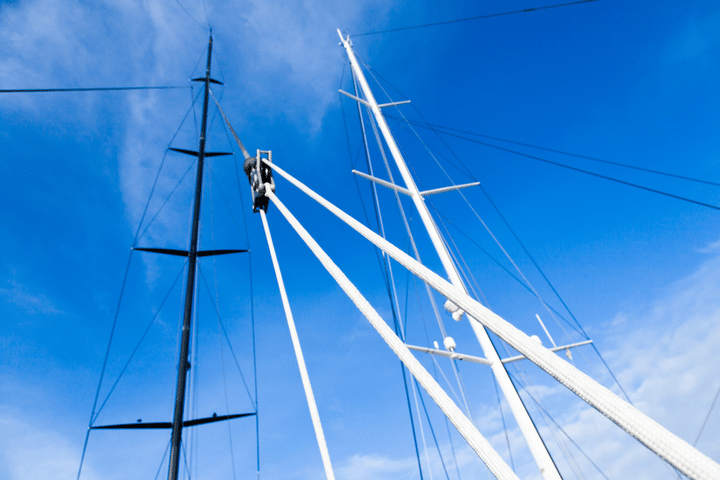
The mast of a sailboat is a tall vertical pole that supports the sails. Larger ships often have multiple masts. The different types of masts are as follows:
(1) The Foremast — This is the first mast near the bow (front) of the boat, and it is the mast that is before the mainmast.
(2) The Mainmast — This is the tallest mast, usually located near the ship’s center.
(3) The Mizzen mast — This is the third mast closest to the stern (back), immediately in the back of the mainmast. It is always shorter than the mainmast and is typically shorter than the foremast.
The Main Sail
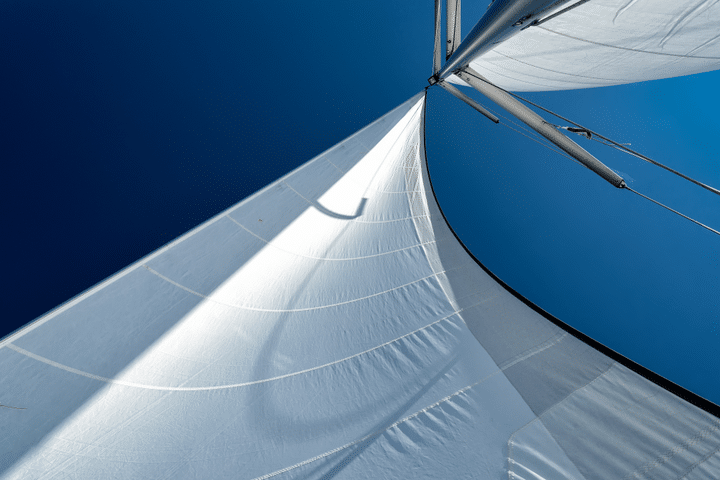
The mainsail is the principal sail on a sailboat, and it is set on the backside of the mainmast. It is the main source that propels the boat windward.
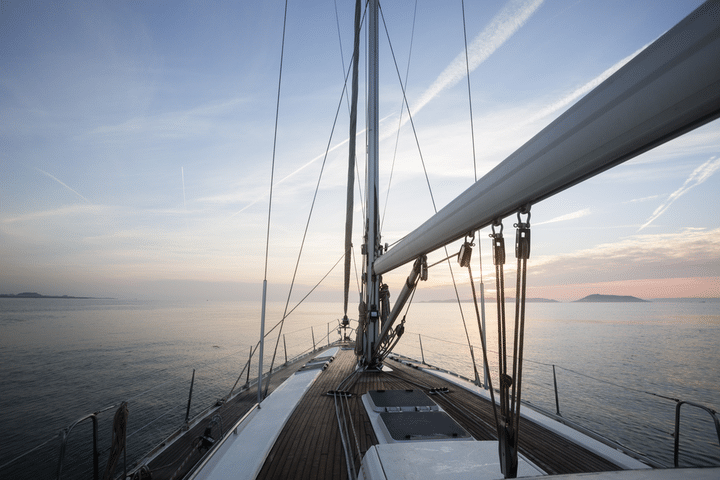
A boom is a spar (a pole made of wood or some other type of lightweight metal) along the bottom of a fore-and-aft rigged sail, which greatly improves the control of the angle and the shape of the sail, making it an indispensable tool for the navigation of the boat by controlling the sailes. The boom’s primary action is to keep the foot (bottom) of the sail flatter when the sail angle is away from the centerline of the sailboat.
The Kicking Strap (Boom Vang)
The boom vang is the line or piston system on a sailboat used to exert a downward force on the boom, enabling one to control the sail’s shape. The vang typically runs from the base of the mast to a point about a third of the way out the boom. It holds the boom down, enabling it to flatten the mainsail.
The Topping Lift
The topping lift is a line that is a part of the rigging on a sailboat, which applies an upward force on a spar (a pole) or a boom. Topping lifts are also used to hold a boom up when it’s sail is lowered. This line runs from the free end of the boom forward to the top of the mast. The line may run over a block at the top of the mast and down the deck to allow it to be adjusted.
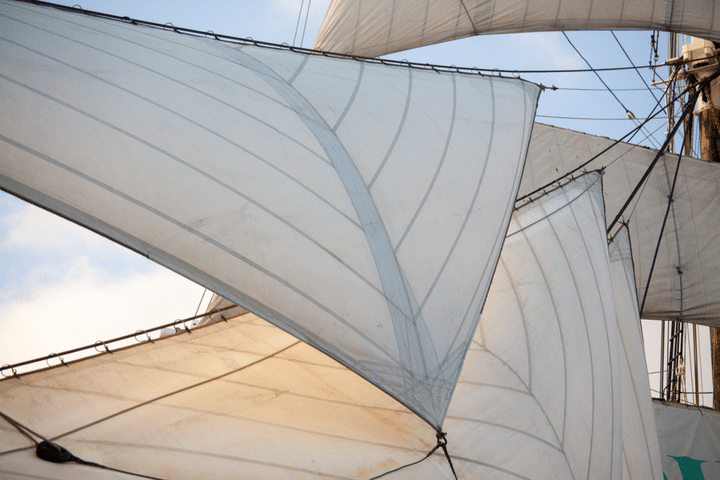
A jib is a triangular staysail set ahead of the foremost mast of a sailboat. Its tack is fixed to the bowsprit, the bow, or the deck between the bowsprit and the foremost mast. Jibs and spinnakers are the two main types of headsails on modern boats.
The Spinnaker
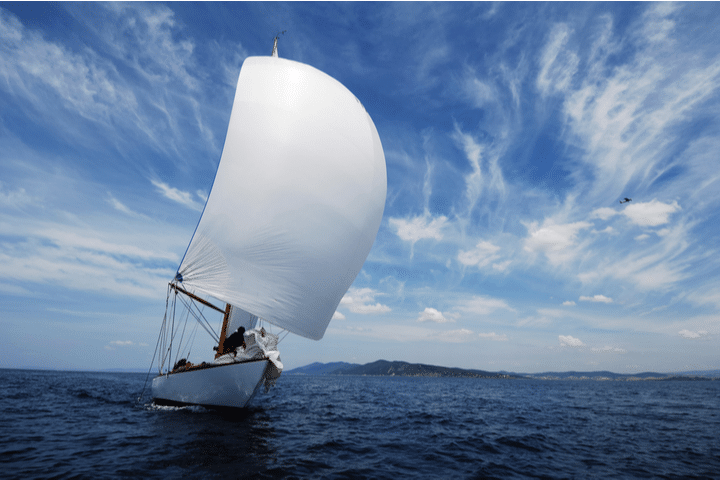
A spinnaker is a type of sail designed specifically for sailing off the wind from a reaching downwind course. The spinnaker fills up with wind and balloons out in front of the sailboat when it is deployed. This maneuver is called “flying.” The spinnaker is constructed of very lightweight material, such a nylon fabric and on many sailing vessels, it is very brightly colored.
Another name for the spinnaker is the “chute” because it often resembles a parachute, both in the material it is constructed from and its appearance when it is full of wind.
People often use the term genoa and jib as if they were the same thing, but there is a marked difference between these two types of sails. A job is no larger than a foretriangle, the triangular area formed by the mast, the deck or bowsprit, and the forestay. On the other hand, a genoa is larger than the jib, with part of the sail going past the mast and overlapping the mainsail. These two sails, however, serve very similar purposes.
The Backstay
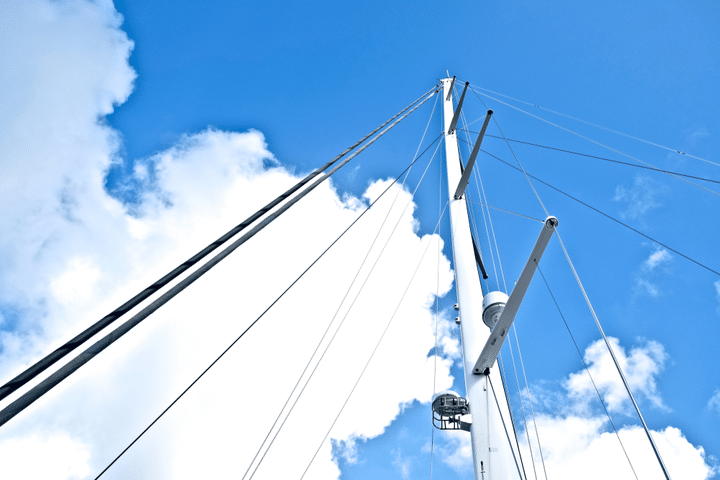
The backstay is a standing rigging that runs from the mast to the transom (the vertical section at the back of the boat), counteracting the forestay and the jib. The backstay is an important sail trip, control and directly affects the mainsail’s shape and the headsail.
There are two general categories of backstays:
1) A permanent backstay is attached to the top of the mast and may or may not be readily adjustable.
2) A running backstay is attached about two-thirds up the mast and sometimes at multiple locations along the mast. Most modern sailboats will have a permanent backstay, and some will have permanent backstays combined with a running backstay.
The Forestay
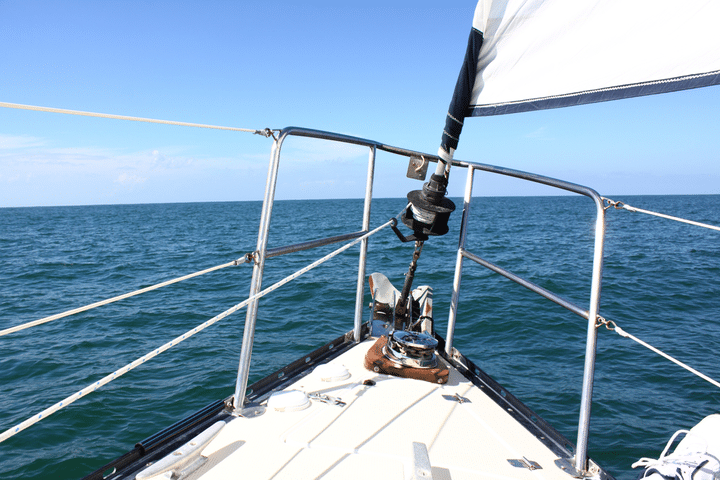
A forestay is a piece of standing rigging that keeps the mast from falling backward. It is attached at the very top of the mast, or at certain points near the top of the mast, with the other end of the forestay being attached to the bow (the front of the boat). Often a sail, such as a jib or a genoa, is attached to the forestay.
A forestay might be made from stainless steel wire, stainless steel rod or carbon rod, or galvanized wire or natural fibers.
Parts of a sail
Sails are vital for sailboats, made up of complex parts that improve performance and maneuverability. In this section, we’ll take a closer look at the different parts of that make up the sails.
Luff – The luff is a vertical sail part that maintains its shape and generates lift by interacting with the wind. It attaches securely with a bolt rope or luff tape for easy hoisting.
Leech – The leech controls air flow and reduces turbulence. Battens or leech lines are used to maintain shape and prevent fluttering.
Foot – The foot of a sail connects the luff and leech at the bottom edge. It helps define the sail’s shape and area. The outhaul is used to adjust its tension and shape.
Head – The sail’s head is where the luff and leech meet. It has a reinforced section for attaching the halyard to raise the sail.
Battens -The b attens are placed horizontally in sail pockets to maintain shape and optimize performance in varying wind conditions. They provide structural support from luff to leech.
Telltales – Sailors use telltales to adjust sail trim and ensure optimal performance.
Clew – The clew is important for shaping the sail and connecting the sheet, which regulates the angle and tension, producing energy. It’s located at the lower back corner of the sail.
Sailing is a favorite pastime for millions of Americans across the country. For some, there is nothing better than gliding across the water propelled by nothing more than the natural force of the wind alone. For both experienced and non-experienced sailors alike, Boatsetter is the perfect place to get your ideal sailboat rental from the mouthwatering Florida keys to the crystal blue waters of the Caribbean .
Smaller sailing boats are perfect for a single day out on the water, either by yourself or with friends and family. In comparison, larger sailing boats and sailing yachts can allow you days of luxury on longer excursions full of adventure and luxury.
Whatever your sailing dreams are, it is always good to know, for both the experienced sailor and the novice, all about the sailboat’s different parts. In this article, we learned all about the boat’s hull, the keel, the rudder, the mast, the mainsail, the boom, the kicking strap (boom vang), the topping lift, the jib, the spinnaker, the genoa, the backstay, and the forestay, which make up the basic parts of any sailboat you might find yourself on.
About us
Boatsetter is the go-to app for boat rentals and on-water experiences. Whatever the adventure, we’ve got a boat for that—Set sail , start the party , go yachting , make your trophy catch , and hone your watersports skills! Download the Boatsetter app ( App Store | Google Play ). Make sure to follow @boatsetter on Instagram, and tag us in all your boat day pictures for the chance to be featured.
Rent. List. Share—Only at Boatsetter

Boatsetter empowers people to explore with confidence by showing them a world of possibility on the water. Rent a boat, list your boat, or become a Boatsetter captain today.
Browse by experience

Explore articles
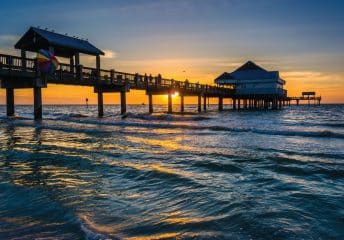
Fishing in Clearwater, FL Guide
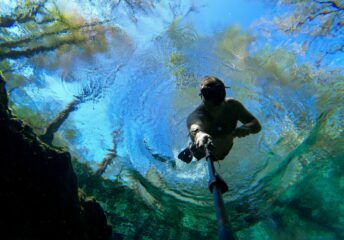
13 Best Snorkeling Spots in Florida
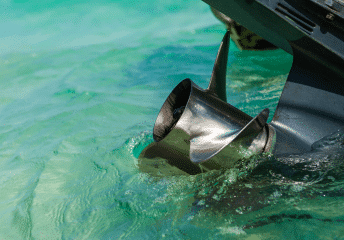
21-pitch prop vs. 19-pitch prop
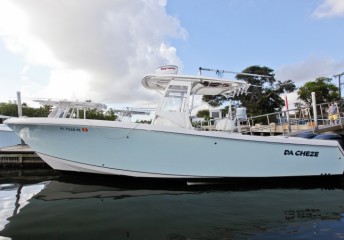
So Many Reasons To Teach Your Child To Fish This Summer
No products in the cart.
Sailing Ellidah is supported by our readers. Buying through our links may earn us an affiliate commission at no extra cost to you.
The Different Parts Of A Sailboat Explained
A sailboat consists of hundreds of parts, each with its specific term and function. From stern to bow, keel to mast, each part and its equipment plays a vital role in making the vessel seaworthy and able to sail.
In this guide, I’ll show you most of the components so you can better understand what they are and their function. We’ll begin with the main components, move to the basic features, and finish with our interior and equipment.
The main parts of a sailboat
The main parts of a sailboat are the key components that make it a vessel able to sail. You’ll notice that the structure has several distinct differences from powerboats.
We can categorize the main parts into the following:
- Hull: The main structure, or “body” part of a boat.
- Keel: The heavy fin at the bottom allows stability under sail.
- Rudder: The fin sticking down at the stern, allowing us to steer the vessel.
- Mast: The “spars” or “poles” holding the sails.
- Rigging: The standing rig is the wires that supports the mast. The running rigging is all the lines that control the sails.
- Boom: The horizontal spar supporting the bottom of the mainsail.
- Sails: The canvas used to harness the energy of the wind.
Let’s dig a bit deeper into each of the components.
Hull – The main structure
A sailboat’s hull is the vessel’s main body or structure. The shape is vital to the boat’s performance and stability, and you have probably seen boats in many different forms. Older vessels are typically narrow, with a rounded underbody and a small stern. Modern designs have a flatter belly and broad stern supporting dual helm stations.
One of the hull’s primary functions is to displace water and provide buoyancy to keep the boat afloat. The hull is also the structure that holds the vessel’s living compartments and all its equipment. The main structure must be strong enough to withstand the forces of the water and any rough weather conditions that Mother Nature might throw at it.
Fiberglass (GRP), steel, aluminum, and wood are the most commonly used hull materials, each with pros and cons.
You can learn more about hull materials and their strengths in this article .
A monohull is a type of sailboat that has a single hull. Monohulls are classified into two categories based on weight and shape: planing and displacement hulls.
Sailboats with more than one hull are called multihulls. There are two types of multihulls: catamarans, which have two, and trimarans, which have three. These boats are typically designed with planing hulls.
Keel – The fin under the boat
The keel of a sailboat is a structural fin that extends downward from the bottom of the hull. There are several types of keels, each with unique characteristics and advantages. They all serve the same fundamental purpose of stabilizing the boat when we sail by adding lateral resistance in the water and weight at the vessel’s bottom.
Standard keel designs include:
- Lifting Keel
Some sailboats have a retractable centerboard functioning as their keel, allowing them to take the boat into shallower areas.
Rudder – To steer the boat
The rudder is a flat surface that sits perpendicular to the waterline. It is connected to the boat by a pivot point, allowing it to swivel left and right. When the steering wheel or tiller is turned, the rudder moves, creating drag in the water causing the boat to turn. The size and shape of the rudder can vary depending on the size and type of boat.
The most commonly seen rudder designs:
- Full skeg-supported
- Semi skeg-supported
Skeg-supported rudders are structurally one of the most reliable and robust constructions, but they are less efficient than a balanced rudder performance-wise. Balanced rudders pivot around their vertical center, giving less drag in the water and higher maneuverability at the cost of being a more vulnerable construction.
Twin rudders are often seen on modern performance sailboats with a wide stern. When the sailboat heel over , the leeward rudder gets better track through the water than a single rudder placed at the vessel’s center line. Contrary to some misconceptions, they can’t be controlled individually, even if the boat has two steering wheels.
Mast and Rigging – Supporting the sails
The mast is the long vertical spar that extends upward from the deck of a sailboat and holds the sails. It is the tallest part of the boat and is typically made of wood, aluminum, or carbon fiber. The mast is held in place by stays and shrouds, which form the sailboat’s standing rigging.
Depending on the rig the boat is manufactured with, there are several different types of masts. For example, a sloop-rigged sailboat will have only one main mast, while a ketch-rigged vessel will have a smaller additional mizzen mast placed further aft from the main mast.
There are two types of rigging:
- The Standing rigging consists of the stays and shrouds that keep the mast or masts in place.
- The Running rigging is the lines we use to hoist, lower, and control the sails.
Pro Tip: “S par” is a general term for a pole made of a solid material like wood, metal, or composite and is used to support a boat’s sail. The mast, boom, spreaders, and poles are defined as spars.
Boom – Supporting the mainsail
The boom is a horizontal beam extending from the mast and supporting the mainsail’s tack and clew (bottom two corners). It is attached to the mast by a hinge called a Gooseneck .
We use the boom to control the shape and angle of the mainsail to optimize its efficiency and power. Some booms also have a Vang or Rod-Kicker installed to assist in trimming the mainsail.
Sails – The canvas used to harness the energy of the wind
Most vessels have at least two sails, depending on the rig type and boat setup.
The Mainsail flies behind the mast, on top of the boom. Although it may not always be the largest sail on the vessel, we commonly refer to it as “the main.”
The Headsail(s ), located in front of the mast, are often of different sizes and shapes, and many sailboats have more than one. The Jib and Genoa are two of the most common types.
Different types of sails are used for various sail plans and situations, and you can learn more about them in this guide .
Now that we had a look at the main parts of the boat, let us dive deeper and look at the rest of the vessel.
The starboard and port side of the boat
Learning about the boat’s components is very important, but we must also know how to orient ourselves on the vessel. Using the words “left and right” on onboard often leads to confusion.
If you refer to something on the left side of the boat, the person facing you will be confused. He won’t know if you are referring to his or your left. This is where the terms “Port” and “ Starboard ” make better sense.
When facing the front of the boat or the bow , your left side of the boat is the port side, and the right-hand side is the starboard . If you turn around and face the back of the boat or the stern , your right-hand side will be the port side.
- A red light identifies the port side of a vessel.
- A green light identifies the starboard side of a vessel.
Windward and Leeward
- The windward side of the boat is the side facing the wind. If the wind comes from your right-hand side while facing forward, the starboard side is windward. This will be the boat’s high side as the wind heels the boat over.
- The leeward side of the boat is the side opposite to the wind. This will be the lower side of the ship while sailing as the wind heels the boat over.
Windward and leeward are two of the most important aspects to understand when sailing and navigating. Not only to identify equipment and gear on each side of the boat but to avoid collisions when sailing close to other vessels. There are rules on the water dictating which boat is “Stand On” and which has to “Give Way” depending on whether you are the windward or the leeward vessel in the situation.
Read this article to access a free course on navigation rules .
Basic parts of a sailboat
The boat’s bow is the front part, typically shaped like a “V” to cut through the waves. Larger vessels often have a locker for their anchor chain in this section, holding the anchor at the front.
The midship section is the center of the boat. Some refer to this part as amidships.
The stern is the rear or back part of the boat. It is also referred to as the aft . I’ve had French crew calling the stern the butt of the vessel, which is funny but also correct!
The beam is the widest part of the boat. Also referred to as the sides on the middle.
The transom is a flat surface across the stern of the boat.
The waterline is the part where the hull (body) of the boat meets the water. Many vessels have a painted stripe to mark the waterline, indicating how loaded the ship is. If you have too much stuff on board, the waterline goes underwater, and it is time to do some housekeeping!
The freeboard is the vertical part of the ship side between the water and the deck. When you see a blue boat like Ellidah, the freeboard is the blue part.
The deck is the “floor” of the boat when you are outside. You have probably heard the term “All hands on deck!” The front deck is the deck space in front of the mast. Side decks are the decks on the boat’s sides.
The mid-deck is between the cockpit and the mast. The aft deck is the deck behind the cockpit. Sailboats with aft cockpits often don’t have any aft decks, but some have a swimming platform instead.
The cockpit is the boat’s steering position and where you will find the helm.
The helm is the position the helmsman uses to steer the boat. Smaller sailboats often use a tiller to navigate, while most bigger yachts have one or two steering wheels.
Main parts below deck (inside the boat)
Let us look at the interior to highlight and learn about the parts we have below the deck.
The Companionway
The companionway is the “front door” of the boat. This is where the steps lead from the cockpit or deck down below. It is usually opened and closed using a hatch, two doors, or a plate.
The Galley
The galley is the boat’s kitchen. This is where sailors prepare their delicious meals.
The Saloon
The saloon is basically the boat’s living room, usually where you find the settee and dinette. This is where delicious meals from the galley are served together with refreshing beverages in good company.
The settee is the sofa or couch in a boat. It is also used as a sea berth to sleep in when sailing.
The dinette is the area where you can sit down at a table and eat your dinner. It’s also perfect for consuming rum and a game of cards in good company.
A cabin is often used as a bedroom in a boat but is not necessarily where you sleep. Many boats have more than one cabin.
A berth is a place in the boat where you can sleep. This doesn’t necessarily have to be a bed and can often include the sleeping space in the saloon. Sea-berth usually refers to a sleeping position where you are tucked well in and can sleep when the boat is heeling over and moving around.
The head is the toilet on a boat. If your skipper tells you to go and clean the head, getting out the shampoo won’t do you any good!
Nav station
The navigation station is usually a chart table and a console with mysterious instruments like radios, switchboards, and complicated electronics. This is where adventures are planned and the skipper’s favorite seat onboard.
The bilge is a space in the bottom of the hull where water collects and sometimes a storage space for all sorts of things. It usually contains a bilge pump to pump out water that finds its way into the boat in various places.
A v-berth is a bed in the front cabin shaped like a V.
A bulkhead is a wall inside the boat, usually supporting the structure.
Hardware and Equipment
Sailboats come equipped with a variety of different hardware and equipment. While the specific items may vary from boat to boat, there are some essentials that nearly every sailboat has.
A winch is a metal drum that gives you a mechanical advantage and is used to control and tighten lines. These can be operated by turning a line around it and pulling manually or by a winch handle to get more force.
Most modern winches are so-called “self-tailing,” which means they lock the line on so you can winch the line without holding on to it. Some boats even have electrical winches operated by a button.
A cleat is a fitting used to fasten a rope. Most boats have at least 6 of these. One on each side on the bow, midship and stern. These are used to secure the boat to a mooring buoy or key. Many ships have more cleats than this for various lines and ropes, and they can be used for anything as they are strong points fitted to the hull.
The sprayhood is the boat’s windshield that protects the people in the cockpit from sea spray. Some vessels have a canvas sprayhood that can be folded down or removed. Others have solid sprayhoods, often called a hard dodger or a doghouse .
The bimini is the cockpit’s “roof.” It protects you from the elements and shelters you from spray, rain, and burning sun rays! A bimini can be made of canvas or hard material. A hard bimini can also be called a hardtop .
Dinghy
A dinghy is a little boat you use to get from the mothership to shore when you are at anchor, also called a tender or annex . It can be everything from a small inflatable rubber kayak to a RIB or even a solid boat.
An essential and valuable piece of kit as it is the daily driver for most cruisers. It is like the car of a land crab, used for all commuting on the water and hauling important stuff like beer, rum, and food onboard. Dinghies often have electric or petrol engines, which we call outboards.
Dinghies are also great to use for watersports, such as wakeboarding!
Like Captain Ron said in the movie, fenders are the rubber bumper things you hang off your boat to prevent it from scratching against something like the pontoon or another ship. It is conveniently also used to sit on or as a backrest while relaxing on deck.
A boat hook is a long stick with a hook at the end. Used to grab lines, items, and stuff that is too far to reach by hand, like cushions flying overboard. It is also convenient as a tool to push the boat away from another craft or the key. Most vessels have them on board.
The guard rail can be a flexible wire or a solid metal rail surrounding the boat to prevent us from falling overboard. Some also use a net as an addition for increased safety.
The pushpit is a metal guard rail around the stern of the boat. This is where the guard rail is secured on the stern: a common place to mount the BBQ, life raft, and the outboard for the dinghy.
The pulpit is the metal guardrail on the bow. This is where the guard rail is secured onto the bow.
The stanchions are the metal bars that keep the guard rail in place around the boat between the pushpit and the pulpit.
An arch is a typical structure made of stainless steel on the back of a boat and is often used to mount a variety of items like antennas, radars, solar panels, wind generators, etc. It is also convenient to use for lifting the dinghy and its outboard.
Ground Tackle
The ground tackle consists of several things:
- Your anchor
- Your anchor chain
- The link between the two
- The connection between the chain and your boat
It includes all equipment holding your boat to the ground. Larger boats sometimes have two anchors on the bow.
A windlass is a winch that hoists and lowers the anchor and chain. Most boats have one on the bow and some on the stern. These incredible things can be electrical or manual (some are both) and are essential to anchor your boat when not in a port or marina.
VHF stands for “Very High-Frequency Radio.” It broadcasts on the VHF network and allows you to communicate with others around you. Sadly, you won’t be able to tune in to your favorite radio show on these.
Still, they are essential for contacting other boats and port authorities. It is also the radio you will transmit an emergency mayday over in case of emergency. VHF radios sometimes require a license, depending on the country you are in.
Chartplotter
A Chartplotter is a navigation computer that shows various information on a screen, like charts, routes, radar images, etc. It is another vital piece of equipment that helps you navigate and maneuver the boat.
Final words
I hope this guide has been helpful and not too overwhelming for you. We’ve covered many of the parts of a sailboat and its terms and functions, but this article only touches on the basics. If you want to keep learning about sailing, I have written several other guides to help you get started.
Now that you have a basic understanding of sailboats, it’s time to take the next step and dive into a sailboat’s standing rigging .
Sharing is caring!
Skipper, Electrician and ROV Pilot
Robin is the founder and owner of Sailing Ellidah and has been living on his sailboat since 2019. He is currently on a journey to sail around the world and is passionate about writing his story and helpful content to inspire others who share his interest in sailing.
Leave a Reply Cancel reply
Your email address will not be published. Required fields are marked *
The whisker poles 101
- The Whisker Pole 101
If you've ever set sail on the open waters, you know the thrill of harnessing the wind to glide effortlessly across the waves. Sailing enthusiasts often explore various techniques to optimize their experience, and two essential components of this endeavor are Genoa Sailing and Downwind Sails . In this article, we'll delve into the world of these techniques, focusing on the key tool in their execution: the Whisker Pole .
Introduction
Sailing represents a harmonious blend of nature's forces and human ingenuity. Whether you're an experienced sailor or a curious novice, understanding advanced techniques like Genoa Sailing and Downwind Sails can elevate your maritime adventure.
Understanding Genoa Sailing
What is a genoa sail.
A Genoa Sail, often referred to as a jib, is a triangular sail that adds remarkable versatility to sailing. Positioned forward of the mast, the Genoa is larger than the standard jib, maximizing the sail area exposed to the wind.
The Role of Genoa in Sailing
The Genoa plays a pivotal role in boosting a sailboat's speed and maneuverability. Its larger size allows for enhanced wiąnd capture, making it particularly effective when sailing upwind or across varying wind conditions.
Unleashing the Power of Genoa Sailing
When you're looking to harness the full potential of the wind, Genoa Sailing is your ticket. The sail's adjustable nature enables you to adapt swiftly to changing wind speeds and angles, giving you an edge in different sailing scenarios.
Mastering Downwind Sails
Sailing with the wind: downwind techniques.
Sailing downwind presents unique challenges and opportunities. To make the most of this orientation, sailors employ specialized downwind sail techniques. These methods optimize the sail's exposure to wind, propelling the boat smoothly across the water.
Exploring Downwind Sail Options
Two popular options for downwind sailing are the Spinnaker and the Jib. The Spinnaker, with its expansive surface area, captures wind from behind, providing a significant push. On the other hand, the Jib is more manageable and easier to control in varying wind strengths.
The Versatility of Spinnaker and Jib Sails
Choosing between the Spinnaker and Jib depends on your sailing goals and crew's expertise. The Spinnaker offers impressive speed but demands skillful handling. Meanwhile, the Jib provides a reliable alternative for a controlled downwind sail.
Read our top notch articles on topics such as sailing, sailing tips and destinations in our Magazine .
Check out our latest sailing content:
The Genoa Sail
Enter the Whisker Pole
Demystifying whisker poles.
The Whisker Pole is a vital tool for sailors engaging in downwind sailing. This adjustable pole attaches to the mast and the jib/genoa, holding the sail out to catch the wind more effectively.
Whisker Pole vs. Spinnaker Pole: Decoding the Difference
It's easy to confuse the Whisker Pole with the Spinnaker Pole, but they serve distinct purposes. The Whisker Pole primarily aids in holding the jib/genoa for efficient downwind sailing, while the Spinnaker Pole supports the spinnaker for broad-reaching or running downwind.
Rigging Your Whisker Pole for Success
Proper rigging is crucial for optimal performance. Attach the whisker pole securely to the mast and the sail, ensuring it's easily adjustable. This setup enhances your sail's aerodynamics and maximizes wind capture.
Perfecting Sail Trim
The art of sail trim.
Sail trim is an art that requires finesse. Adjusting the sail's shape, angle, and tension directly affects your boat's speed and stability. Mastering sail trim ensures efficient energy transfer from wind to motion.
Sail Trim Charts: Your Ultimate Guide
Sail trim charts provide valuable reference points for different wind conditions. These guides assist sailors in achieving the perfect balance between sail shape and wind angle, enhancing both performance and safety.
Genoa Sailing on Your Sailboat
Genoa sailboats: what sets them apart.
Genoa sailboats are tailored for optimal use of Genoa Sails. These vessels boast enhanced maneuverability and speed, making them ideal for sailors who relish challenging wind conditions.
Genoa Jib: Navigating the Waters with Precision
The Genoa Jib, a staple of Genoa sailboats, demands special attention. Its larger size necessitates judicious sail trim adjustments and effective use of the Whisker Pole for a seamless downwind experience.
Sailing is a captivating journey that intertwines human skill and the natural elements. Embracing Genoa Sailing and mastering Downwind Sail techniques can transform your sailing escapades into remarkable adventures. With the Whisker Pole as your ally, you'll harness the wind's power like never before.
So what are you waiting for? Take a look at our range of charter boats and head to some of our favourite sailing destinations.
I can help you choose the right boat for your holiday. Contact me.

Denisa Nguyenová
Have Wind Will Travel
Curious about cruising? Come aboard.

BV19: How To Rig a Whisker Pole
Or how we rig it on OUR BOAT, I should say. Ahoy followers! You ready for a little virtual sailing lesson? That’s right, float away from your desk for a minute, imagine yourself on the sunny deck of a gently-swaying boat, looking out over green, glistening water. Can you smell the salt in the air? I hope so! But, there’s only one thing that’s bugging you: that occasional luff-crumple-pop of the headsail. The light winds over the stern combined with a kicked-up sea state is causing your easy downwind run to be much more of a strain on your headsail than you would like. Every third wave, she luffs, curls, and then snaps back out with a vicious pop when she fills again. I know you’re cringing right now hearing it. So, what do you do?
Rig a whisker pole!

We’re going to share with you today a detailed step-by-step process, with photos, of our whisker-rigging method as well as some tricks and very important lessons we learned when first working with and learning how to rig the whisker pole on our boat while we were cruising in the Bahamas, namely the following:
- Where to attach the outer end of the pole (the Pam Wall Rule).
- What else to attach to the pole (the Captain Frazer Rule).
- And, where to attach the pole first (the HaveWind Rule).
All lessons are free today. Feel free to learn some at our expense!
No one likes to hear a sail pop and flail. I always feel like it’s a dog yapping and running around in circles because thunder scared him. You just want to hold him close and calm him down. Yes, I would do that with our sails if I could. In a heartbeat. But, unfortunately, I can’t. Trust me, I’ve tried. Our jib just kicked and squirmed and whacked me solid across the face. Thanks Wendy . Don’t try to be a human whisker pole. Be smarter than me.
As I mentioned in the spinnaker trainer video I shared in our spinnaker video last week and in our Bahamas Boat Project Recap , for Phillip and I, getting our whisker pole functioning and learning how to safely and comfortably rig it ourselves underway, was one of our big “sail plan” goals last year while we were preparing for our trip to the Bahamas. Our sail to Cuba in 2016—bashing for days into strong head winds—taught us many things. One was that we needed to expand our sail plan and hone our sail skills to have more options to keep our boat and the crew sailing safely and more comfortably in a variety of wind speeds and directions. Mastering the whisker pole was a key factor in that.
If you recall, in our Bahamas Boat Project Recap , I talked about what we had to do to get our whisker pole ready for cruising. While she came with the boat, and rode with us idly for many years in two handy little stanchion post brackets on the starboard side near the bow, we had not actually used our whisker pole for years because she had a glitch. She had a rather significant dent that prevented us from being able to slide the extension out to make it long enough to actually reach the sheet of the sail. This meant for years we were lazy and just didn’t use her. Bad sailors! You can say the same thing about us with the spinnaker. We didn’t bust ours out on the boat for years just because we thought she would be big and cumbersome and we might rip her during the launch or douse. Again, bad sailors! Why would you skip out on allll this awesomeness over fear of failure!

We’ve since learned you have to just get out there and try stuff. If you’re afraid you might damage a system because you don’t know exactly how it works, then ask a more experienced sailor to come out on a sail with you (offer beer or other booze and snacks, of course) and figure it out. Yeah, you might break something, or find something was on the verge of breaking anyway, but it would be better to break it or find our it was about to in the comfort of your home waters, not while underway across the Gulf or some other blue-water body, am I right? As a good friend of ours often says (Tom, if you’re reading this), when the sailing gets boring, he smacks his hands together and says: “Time to break some shit!” It is a saying Phillip and I have readily adopted on our boat, hand-clap and all.
You can’t be afraid to try something out just because you might break it. And, I can say all of that lofty inspirational stuff now because Phillip and I were pansies for years and did not fly our spinnaker or use our whisker pole simply because we didn’t quite know how and didn’t take the time to figure them out, get them working, and get ourselves used to using them. Shame on us, I know! But, that’s why I can boldly write this post, because we have since done just that and I’m proud to share.
Now, the dent in our whisker pole. That was a fun story. Phillip had the idea for me (and specifically me, specifically in spandex) to take our dented pole to an auto body shop to see if they could work the dent out (much like they do on vehicles) to get the pole’s extension capabilities functioning again. And while I had every intention of paying them for their work, the guys had such a great time ribbing each other and working on this “oddball boat thing” they called it, seeing who could work the ding out the best, while I watched in spandex, that they just did it for free. I tried and offered repeatedly to pay, but the owner, Travis, said it was such a fun show to watch, he was happy to help a local for free. So, many thanks again to the great guys at Coastal Body Works here in Pensacola for getting these sailors up and going again!

Once we had the whisker pole working, we then started to toodle around with it on the boat and found that while a whisker pole can be very useful in light winds where it’s not quite enough to keep the headsail full or not the right angle for you to fly the spinnaker, what we learned during many of our downwind sails during our time in the Bahamas, was that it can also be useful when there is enough wind for your headsail, but a churned-up sea state, and accompanying erratic movement of the boat, keeps causing the sail to cave, crumple, and snap back with a bang. Not cool . This was one of our biggest “aha!” moments with our whisker pole. You can see in this photo the sail is luffing and will soon snap back once the boat tips and it fills with wind.

As we all know, luffing and popping is not good for the sail. And we had some decent wind here in this photo. I believe it was blowing around 8-9 kts, plenty to keep the sail full … in smooth seas, but not enough to keep her taut when the boat is bucking around in churned-up 2-3 footers. What Phillip and I did not know, initially, was that the whisker pole was something we could not only use to get more wind in the sail on a light-wind downwind run, but also something that could prevent luffing and popping in kicked-up seas. Very cool.
And once you rig it in some funky seas, you’ll find the boat rides smoother. The crew is more comfortable not having to listen to that occasional crumple and bang. And, the boat is infinitely grateful for the more comfortable set-up. Having made several mistakes in the beginning (don’t we all?) Phillip and I learned a few helpful tricks that allow us to easily rig the pole in most conditions and to even furl up the headsail quickly without having to un-rig the pole. Pretty cool, huh? Now, I will be the first to admit most of these very cool tricks were learned at the hands of other, more experienced, sailors: friends and mentors who have many (many!) more blue-water miles under their belts than we do, and from whom we love to learn. So, a big thanks in advance to the ever-amazing Pam Wall and our fellow Captain and friend in Marathon, Captain Russell Frazer, and his exceptionally-skilled wife, Lynn, for sharing some of these tips with us.
Our Three Biggest Whisker Pole Lessons
- Attach the pole to the sheet, NOT the clew of the sail (The Pam Wall Rule)
- Rig preventers fore and aft (The Capt. Frazer Rule)
- Attach the pole to the sheet first, THEN the mast (The HaveWind Rule)
The Pam Wall Rule: Attach the pole to the sheet NOT the sail
I actually recall when we were speaking with Pam about this. It was during a work/play trip to Ft. Lauderdale. Sometime in the spring of 2016, I believe. And she and Phillip got to talking about this whisker thing on the boat. I wasn’t really sure what they were talking about, but I always hate to interrupt because of my own confusion (because it’s so frequent) so I did what I often do in a situation like that. Pretend and nod and try to say stuff that won’t expose my ignorance. I remember Pam mentioning some sail training video she had been involved with but when she saw the final product, and the “whisker pole was attached to the clew! The clew?!” (she shouted) she told the production company she did not want her name anywhere near it, because that was not right.
Now, did Pam’s comment make sense to you? Me, I had no clew, pun intended. At the time, that is. I’ll be the first to admit how much more I still have to learn about sailing, but I have come leaps and bounds since my first few years with Phillip and, thankfully, that makes sense to me … now. Phillip, who knew immediately what Pam was talking about then and who fervently agreed, won her salty, sailing heart over right then and there. Pam’s a sucker for a good sailor. Sorry, Pam, the word is out. But, it didn’t come full circle for me until Phillip and I began rigging up our own pole on our boat and I then realized why attaching the pole to the CLEW was just about the worst thing you could do.
Imagine if, for some reason, somehow, someway, that pole got unclipped from the mast. Because that never happens on boats, right? Something that was once fastened becomes unfastened? It could get whacked, cracked, loosened, a number of freak things that happen often underseas on a pitching, yawing boat. Now think what would happen if that pole came unattached at the mast and it was attached not to the genny sheet, but to the clew of your sail. Do you see it? A huge pole being flailed and clanged and beat around on the front of your boat? It’s like the genny is a big ring master and the pole at the end of her sail is like a big metal bullwhip. She’s slashing and snapping just for the fun of it! And, how do you get that pole secure? Without getting knocked unconscious first? The answer is: you may not. Finding your headsail with the leeway to sling and bang that thing around however she would like is not a situation you want to be in. While there may be a bang or two if the pole comes unattached at the mast and is attached only to the sheet, eventually the pole will likely settle to a fairly-secure place on deck or get tossed overboard and remain hanging from the sheet into the water. Which outcome would you prefer to find yourself in? The bullwhip or the dangler?
Now that the “clue” makes sense to you, take a very good lesson from Pam and apply it on your own boat: NEVER ATTACH THE POLE TO THE SAIL, ATTACH IT TO THE SHEET.
Thank you Pam. Moving on.
The Captain Frazer Rule: Rig preventers fore and aft
While Phillip and I had thought about rigging a preventer forward, to the bow, and did that on our own initiative the first few times we used the whisker pole, we did not rig one aft. The preventer we ran to the bow was primarily needed, in our opinion, to prevent the pole from flying back and banging the shrouds. We put waaaaayyy too much work into those shrouds when we re-did the rigging (from rod to wire) in 2016 to have anything slam into them. Protect those shrouds people! But, we had not yet run one aft, until we talked to a good friend of mine, Captain Russell Frazer and his wife, Lynn, who are both very experienced fellow sailors in Marathon, about our travels when we returned from the Bahamas back in March of this year. Russell suggested running preventers both forward and aft so that you can roll the headsail up while still leaving the pole and its rigging in place.
This is another situation where rigging the pole to the sheet not the clew of the sail proves, once again, useful. If the pole is attached only to the sheet, the sheet will then run smoothly through the mouth of the pole, allowing you to furl the sail up while the pole—held fast with the topping lift and two preventers—remains firmly in place for you to deal with at a safer time. Imagine something crazy happened on deck (because that’s always possible), the seas kicked up and some metal piece flew off and put a nice rip in your headsail. You want to get it furled (if you have a furling headsail) as quickly as possible to keep the wind out of it and prevent it from ripping further, or worse, shredding entirely. If you have to go topside and un-rig the pole before you can furl the sail, you’ll have to leave your sail exposed and vulnerable while you do that, and if the seas are kicked up and things are flying around on deck, that’s not a time you want to be going topside and trying to wrestle a whisker pole anyway. Instead, if you can simply furl the sail while leaving the pole securely in place until it is safer to go disassemble the rig, that would be a much better alternative.
So, the Captain Russell Rule: rig a preventer fore and aft. And, thank Russell and his wife, Lynn, for that one!
The HaveWind Rule:
Attach the pole to the sheet first, then the mast
Boy, did it take Phillip and I a while to get this one. Granted, we probably could have done a little more research before we got out there (this was on our way across the Gulf headed down to the Bahamas, our last day on a five-day run, almost to Key West), and we are doing it all so totally wrong. Tssk tssk sailors!

We had decided to just “play around” with the whisker pole then, having not read much or watched detailed videos on the best way to rig it before just getting out there and tangling ourselves up in it. We usually choose that method, though. Part of it is kind of fun to figure it out yourself on your own boat and we would much rather be tinkering around with it hands-on, out in the sun, on the boat, than watching a video at home. So, if it’s safe to learn OTB (on the boat), we like to do that.
But our efforts proved in vain here, as our first time trying to use the whisker pole we found ourselves struggling to keep a hold of our preventers and make everything work by attaching the pole first to the mast, then trying to finagle the swinging end of the pole, six feet away, to make it magically snag the sheet. Silly us. I know. We just hadn’t thought it all the way through yet and were still tinkering.

After some experiments, we found it was much (much!) easier to first attach the pole to the sheet. I usually do this while Phillip is holding the rest of the weight of the pole on the other side of the boat. We have our two preventers, fore and aft, attached to the end of the pole at this time, and I usually have to push the pole out only about 2-3 feet over the side of the boat to get to the sheet. We then use the pull line (I’ll call it that) that runs the length of the whisker pole and allows us to open the mouth of the pole from afar. Once the mouth of the pole is attached to the sheet (not the clew remember!), I then push the pole slowly out while keeping a hand on my preventers. You can either have these lying on the deck in preparation for cleating once the pole is up, or (if you’re really good and have them pre-marked or you’re just a much better guess of distance than I am) you can have them pre-fed under the lifelines and down to their respective cleats before you push the pole out. We haven’t got that cool … yet! Phillip then pushes the pole out its entire length while I keep a hand on the preventers and attaches it at the mast. Then voila! the pole is up and holding our headsail out in a nice open and secure position.
We have found on lumpy downwind runs, this is a great way to get a little extra oomph out of light winds and some better rest for the boat and crew as she sails much more comfortably and quietly without the sail luffing and popping during the entire passage.
So, for a quick re-cap, this is our procedure, start to finish, of how Phillip and I rig the whisker pole on our boat. As always, we welcome feedback, and hope this helps some of you bust out your own pole and start using it too!
How We Rig the Whisker Pole On Our Boat
1. Check the integrity and functionality of the pole and its pull line (the line that runs the length of the pole and is used to open the mouth of the pole from afar). Look to make sure there are no major chafe points in the line, or areas where the line looks like it might break). Make sure the mouth opens and closes easily on each end of the pole. (Fighting that thing, once the pole is out and mobile, in seas is not something you want to do). After years of no use, sitting up under the sun on our deck, we found our pull line had deteriorated and it broke clean in two the first time I pulled it (that’s why ours is wrapped around the pole in the photo here, we haven’t yet fixed it). But a severed pull line is not something you want to happen underway when you cannot easily or safely reach your hands out to the end of the pole to detach it or you are forced to wrestle a pole on deck that is still gripped to your headsail sheet with a bad case of clench jaw.

2. Once you confirmed the pole and its moving parts are working great, take the pole out of its holster and lay it athwartship (or hold it in hand or in your lap, with preferably two crew) while you attach the fore and aft preventers at the opening behind the mouth at the outer end of the pole. You can then run the preventers out and back under the lifelines to their respective cleats if you would like, or let them fall free to the deck. As Phillip and I get better at this, I plan to have two preventers with lengths pre-marked so I know how far off to cleat them in advance. We attach our preventers to this opening (arrows below) behind the mouth of the pole, which is on both ends, where the topping lift also connects at the other end of the pole.

3. With one crew member holding the pole on deck, the other crew member will raise the end of the pole by pulling and cleating the topping lift for the pole. This is just an eyeball method to raise the pole roughly to the height of the clew of the sail. If you are single-handed, I imagine you could attach the pole to the mast and deck cleats to secure it temporarily for this step, then detach them after you’ve lifted the pole so you can then attach it to the sheet.
4. Loosen the sheet of the headsail so you will have enough slack to extend the pole out from the mast. (You can imagine how Phillip and I learned this one the hard way trying to wrestle that pole out. It was just inches from the mast and we were pushing with all of our might, a definite set-up for a slip and fall, before we realized we were fighting the sail itself.)
5. Attach the mouth of the pole to the working sheet of the headsail. Remember the Pam Wall rule: do NOT attach it to the clew of the sail. Attach it to the sheet. I usually have the pole extended about 2-3 feet over the side of the boat (with Phillip holding the other side near the mast), and I attach it to the sheet by setting the teeth (we’ll call them) on the sheet, then pulling the pull line from afar and the mouth then opens and drops down to snap around the sheet. My preventers, fore and aft, are attached at the time to that opening behind the mouth, and I am usually holding both preventers in my hands around the pole while I push it out. You can see in the photo below, the pole is locked around the working sheet of our jib, right behind the bowline knot. Our aft preventer has been computer-graphically inserted (as I mentioned we hadn’t yet learned to run one aft).

6. Then slowly push the pole out (running the preventers through your hand on the pole, if they are not pre-cleated, so they do not go overboard), until the other end of the pole reaches the mast.
7. Attach the other end of the pole to the ring at the mast.

8. Secure or trim your fore and aft preventers making sure the pole cannot hit the shrouds. I like to push my weight against the pole toward the stern making sure it cannot be pushed back and make contact with the shrouds, if so, I will tighten the forward preventer.

9. That’s it! You’re sailing under the whisker pole! Sit back and enjoy the no-luff-and-bang ride!
10. When you’re ready to disassemble, remember, if you would like, you can furl the sail under pole, leaving the pole (secure under its topping lift and two preventers), firmly in place and then disassemble the rig once the sail is secure. Or, you can disassemble the whisker pole rig with the sail remaining out by simply following the previous steps in reverse.

I was so happy when we got this thing rigged up, I did a dance. A pole dance.

Sorry, couldn’t help it. Yes, that is totally me. 100%. Every single rib. All 40 of ‘em. Yep.
Happy sailing folks!
Share this:
11 thoughts on “ bv19: how to rig a whisker pole ”.
Great info Annie, very informative!
Why thank you Sir Bacchus! Hope you two (nay three!) are enjoying your cruising!
Thanks for this one Annie. You speak from the heart. Makes me realize all this salty knowledge doesn’t just happen and we shouldn’t be ashamed of our learning curve. I have the pole and just like you have barely used it. Not anymore!
Thanks for the knowledge and stay safe during Hurricane season! SV Ausdauer
Wow, what an awesome comment to receive here. We really appreciate that. Phillip and I certainly are no experts, but we do try to push ourselves at time to try new things and learn new methods of going about it, and we always like to share. Hope this helps you whip that pole out and go to it! Have fun out there, and hope you stay safe, too. I’m watching Beryl right now, bear down near some friends of ours in the ABCs. I do not like hurricane season. I do not like it at all! > : (
Save that last pole picture for a book cover it would be beautiful and perfect!!!!
Thank you for this amazing and thorough article – I have a question I’m hoping you can help with. It appears that your shrouds run fore and aft of your mast like The ones on my 1964 Pearson commander. Are you attaching the mast end of your whisker pole to a ring on your mast or to port and starboard rings on the fore deck – and if you are attaching it to a ring on the mast are you relying strictly on that fore guy to keep it from banging into the shrouds? Also it appears in one of the pictures-and this may be an allusion-that in one case you have the whisker pole mounted between shrouds-am I seeing this correctly?
Hey Scott. Thanks for following along and reaching out. I’m glad this post was helpful for you. As I mentioned in the article, for years we hesitated to use our whisker pole because we just didn’t know quite how to rig it right. But in the right conditions (a light, bumpy downwind passage) it makes a big difference. We attach our mast end of the pole to a ring at the mast. The pole sits forward of all shrouds (not in between them). We tie a preventer to the bow to keep the pole from swinging back and hitting the forward shroud. We also tie a preventer aft as well to hold the pole in place. When completely rigged, we have three lines holding the bitter end of the pole in place (the topping lift and two preventers running forward and aft). The aft preventer allows us to furl the head sail up through the pole, leaving the pole in place. Hope that helps you! Happy sailing!
Late to this post but so very happy to find it. after reading this I believe we are ready to set our whisker pole for the first time on our (non-furling) 130% genoa. If I’m reading this right we need three (3) lines on the outboard end of the whisker pole (a topping lift plus fore and aft preventers) in addition to the sheet running through the jaws. I think I’ll try to rig the forward preventer through a block attached to the bottom of the pulpit and running back to the cockpit and cleated-off so that any fine fore/aft tuning can be made with out going forward. Thanks again for the post!
Hey Bob! So glad you found the post and that it was helpful. That whisker pole felt like a big riddle for us for a long time. The three “rules” I mention in the article definitely cleared it up for us. And, yes, you are correct, we attach three (3) lines to our pole when rigging: 1) the topping lift to raise it; 2) a foreword preventer; and 3) an aft preventer. Good luck with it! Happy sailing!
why do you not rig the pole with the headsail completely furled and out of the way? I can easily handle my pole solo using this method.
The best answer? Because we were (are still?) novices. You’re absolutely right, Jeff. We have since learned setting up the pole (with the headsail furled and simply running the working sheet through the jaw of the pole) before unfurling the sail is much easier. It always nice to know, too, with the pole secure and independent of the sail, that we can furl anytime and just leave the pole out there. Appreciate your insight. Impressive you can do it solo. Kudos!
Leave a Reply Cancel reply
Discover more from have wind will travel.
Subscribe now to keep reading and get access to the full archive.
Type your email…
Continue reading
- Weekly Newsletter
California's Boating & Fishing News

Sailing 101: The Anatomy of the Sailboat
Ahoy sailors, welcome to the first article in a new series set on giving you a complete guide to the world of sailing. The Log will be compiling sailing information from experts so you will be well-versed in sailing in no time.
SOUTHERN CALIF.— There are many ways to learn to sail. You can jump in the boat with a friend and learn from experience, you can sign up for formal lessons, or if you can get your hands on a boat, you can try and teach yourself. No matter which method you prefer, it’s necessary to understand the boat and what it can do out on the water before you dive into your education.
The Basics of a Sailboat
Before setting sail, there is much you need to know. Gaining a basic knowledge of the boat’s anatomy will help the new sailor familiarize themselves with where and how the boat operates. Knowing the different parts of the sailboat is important for both safety and being able to sail your boat as flawlessly as possible.
- Block: This is the nautical term for a pulley.
- Boom: The horizontal support for the foot of the mainsail extends aft of the mast. Aft is the rear of the ship, at the direction of the ship’s stern. This is what you want to watch out for when changing directions in a sailboat. It can give you quite a bump on the head if it hits you.
- Bow: This is what the front of the boat is called.
- Centerboard: This is a (usually fiberglass) plate that pivots from the bottom of the keel (a flat blade sticking down into the water from the bottom of the sailboat) in some boats and balances the vessel when under sail.
- Cleat: Cleats are what lines (or ropes) get fastened to when they need to be kept tight.
- Halyard: Lines that raise or lower the sails. (Along with the sheets, aka running rigging.)
- Hull: The hull is the boat’s body and consists of everything below the deck.
- Jib: This is the sail at the bow of the boat. The jib helps propel the boat forward.
- Genoa: A foresail that is larger than a jib.
- Keel: The keel is what prevents a boat from sliding sideways (“making leeway”) in whatever way the wind is blowing and stabilizes the boat.
- Line: Lines are ropes. They are everywhere on boats. There is only one “rope” on a sailboat, the bolt rope that runs along the mainsail’s foot.
- Mainsail: It’s all in the name; this is the boat’s mainsail. It is the sail attached to the back of the mast.
- Mast: The mast is a large, vertical pole that holds the sails up. Some boats have more than one mast.
- Painter: This is a line positioned at the front of small boats. It is used to tie the boat to a dock or another boat.
- Rudder: The rudder is how the boat is steered. It is movable so that when you turn the wheel or tiller, the rudder directs the boat in the direction you would like to go.
- Sheets: The lines that control the sails, (also known as running rigging.)
- Spinnaker: The usually brightly colored sail used when sailing downwind or across the wind.
- Stays and Shrouds: Some wires ensure the mast stays upright, even in hefty winds, (also known as standing rigging.)
- Stern: The back of the boat.
- Tiller: The tiller is a stick attached to the rudder and controls the rudder.
- Transom: This can also be called the butt of the boat. It is the back part of the boat perpendicular to its centerline.
- Wheel: The wheel works the rudder, steering the boat.
- Winch: Winches help tighten the sheets and halyards. When these lines are wrapped around a winch (in a clockwise direction), a sailor can turn the winch with a winch handle, providing mechanical advantage, which makes it easier to bring in the lines.
Study these terms and distinguish where they are located on the boat. Retain that knowledge while the Log prepares for the next lesson in Sailing 101.
Share This:
- ← Blips on the Radar: Southern California oil spill
- Fast Facts: Red Light, Green Light →
One thought on “ Sailing 101: The Anatomy of the Sailboat ”
The timing of your article Sailing 101 turns out to be perfect for myself as I set a new course and plan to learn how to sail. After a lifetime of boating starting on the northeast coast and now in southern California, I have been fortunate to enjoy various types of power boats including trawlers. Now that my wife is done with boating I needed to find something to keep me on the water and stay young. Why not sailing? After a yearlong search for the “right boat” I commissioned the build of a 16′ Sandpiper Catsailboat built by Marshall Marine Corp, in Maine. With the boats ultra-wide beam of 7′ I felt it would offer the greatest stability for a beginner and its great classic looks add to its appeal. I look forward to following your article and learn as much as possible. Thank you

Comments Cancel reply
Your email address will not be published. Required fields are marked *
Your Thoughts are Appreciated
Save my name, email, and website in this browser for the next time I comment.

Parts of a Sailboat

Last Updated by
Daniel Wade
September 28, 2022
Sailboats share many parts with other boats, such as keels, decks, and sometimes engines. But parts like halyards, sheets, and blocks are unique to sailboats.
Sailboats require four main parts to operate: a hull, mast, sail, and rudder. The hull is the body of the boat, and all other parts are directly or indirectly connected to it. The mast is a long pole that serves as a guide and mounting point for the sail. The sail catches the wind and propels the boat, and the rudder directs the boat and acts as its steering.
Here are all the main parts of a typical cruising sailboat , including hardware, lines, controls, cabin items, and a rundown of common sailing terminology.
Table of contents
Port, Starboard, Bow, Stem, and Stern
Before we get into the parts of a sailboat, let’s get a handle on sailboat direction. The bow of the boat is the front (forward), and the stern is the rear (aft). The stem is the forward-most part of the bow and determines its shape. These words describe the general area of front and back.
When determining port and starboard, picture looking down on the boat with the bow oriented forward. The port side is the left side of the boat, and the starboard is the right side. Now picture yourself at the controls of your boat.
If your lookout sees an obstacle off the port bow, which direction should you look? That’s right—the obstacle is forward and to the left of you. Now, we’ll go over the basic parts of a sailboat.
Basic Parts of a Sailboat
What are the basic parts of a sailboat? These are items that are essential to the operation of the boat and universal across most sailing craft. Every sailor should know where these parts are and what they do. Here are nine fundamental sailboat parts, their function, and why they’re important.
The hull is the ‘boat’ itself. It comprises the frame of the boat, the skin that keeps the water out and serves as the mounting point for everything else on the boat (both directly and indirectly). Simply put, if you punch a hole in the hull, water will come into the boat. Sailboat hulls are constructed most commonly out of fiberglass or hardwood (such as white oak), but some boat hulls are made out of aluminum, steel, and even a material called ferrocement.
The deck is the platform that covers the hull. It’s the place where you walk when you’re not inside the boat. Most people would consider the deck as any place ‘on top’ of the hull. The deck serves as a mounting point for essential boat hardware such as the mast and winches. We’ll get into those later; just think of the deck as the visible top area of the vessel. Decks are often made of fiberglass as well, but traditional boats use teak wood planking in this area. You’ll often find abrasive anti-slip material on the deck, as sailors often walk across it in wet conditions.
The keel is the structural backbone of the boat. It’s located in the bottom of the hull and serves as a sort of ‘spine’ to which all frame members are mounted during construction. The keel is an essential part of the boat and cannot be broken or damaged. You’ll often hear the term ‘keelboat’ in the sailing community. This word describes a sailboat with a long and deep keel, which is like a thin fin that runs the length of the hull. Keelboats are seaworthy vessels, as the elongated hull adds stability and keeps the boat on a straight track.
Centerboard
Many sailboats don’t have a long, deep keel, but they still need some sort of fin to keep the boat tracking straight. To substitute a long keel, many boats utilize a dagger-like board called a centerboard . This plate protrudes underneath the center of the boat, usually between one and three feet below the bottom of the hull. Centerboards are often retractable, which is great for towing and beaching. Centerboards are most common on small sailboats designed for inland or coastal cruising.
The cockpit is usually located in the rear of the boat. It features seating for the crew and controls for the steering, sails, and engine. The cockpit is the command center of the sailboat and often features storage lockers under the seats. Many cockpits are self-draining, which means they’re located above the water line and clear themselves of water accumulation. Some sailboats have enclosed cockpits for off-shore sailing. In a typical cruising sailboat , the cockpit usually takes up ⅓ of the total length of the boat or less.
The mast is the big pole extending from the deck of the sailboat. It connects the sail to the boat and serves as a frame for all sails carried by the vessel. The mast is a key part of the sail plan and helps determine what kind of boat you’re looking at. Most sailboats have just one mast, but others have numerous masts. A schooner, for example, has two masts and a specific sail plan. A yawl also has two, but each mast serves a separate function.
The rudder steers the boat and is located on or under the stern of the vessel. Rudders are an essential part of the boat, and they’re particularly sensitive to impact or misalignment. On some boats, the rudder is completely invisible when in the water. Other boats have retractable rudders for beaching or towing. Fundamentally, a rudder is just a plate that’s hinged to move side to side. It’s connected to the tiller or the helm, which we’ll cover in a bit.
The sail is what propels the boat, and most boats have more than one. The aft (rear) sail on a single-masted boat is called the mainsail , and it’s the largest of the two primary sails. The triangular forward (front) sail is called the jib, and it’s generally smaller than the mainsail. Other sails include the spinnaker, which is like a loosely-mounted parachute that flies in front of the boat during conditions of low wind.
The boom is a hinged rod that extends perpendicular to the mast. It’s mounted on the lower part of the mast, and it controls the side-to-side position of the mainsail. The best way to remember the boom is to consider what happens when it swings side to side. If you’re not paying attention, a swinging boom could give you a nice crack on the head. Think of the boom as the throttle of the boat. If you’re properly pointed relative to the wind, pulling in the boom will increase the speed of the boat. This is where the bottom of the sail connects to the mast. The boom is also connected to the deck and adjustable using a winch and a crank.
Here is some of the hardware you’ll find on a typical sailboat. These items are usually mounted to the hull, on the deck, or to the mast. Boat hardware consists of control systems and other items that are essential to the operation or integrity of the boat.
Cleats are the universal mounting points for ropes on the deck. Cleats are used for tying up to the dock, securing lines, and tethering important items that can’t fall overboard. There’s a special kind of knot called a ‘cleat knot,’ which is essential to learn before sailing. A properly tied cleat will stay secure in almost all conditions, and it’ll be easy to untie if the need arises. An important distinction must be made for clam cleats, which are spring-loaded sets of jaws that secure rigging lines that need to be adjusted frequently.
Block is a nautical word for a pulley. Blocks (pulleys) are everywhere on a sailboat, and they’re an essential part of the rigging system. Blocks distribute and regulate force. For example, a deck-mounted block can change the direction of a line from vertical to horizontal, allowing you to apply a horizontal force to lift something vertically. Blocks also reduce the force required to lift heavy loads and help make adjustments more precise.
Winches are cylindrical mechanical devices that transmit force. Winches are often located on either side of the boat. They’re multi-directional like a socket wrench and feature one-way locking mechanisms for raising, lowering, tightening, and loosening lines. Winches have a hole in the top for a crank, which makes it easy to wind rope in and out. Winches are present on almost every medium to large sailboat. They’re either manual or electrically-powered.
A hatch is a watertight or water-resistant door used to enter the cabin or storage compartment of a boat. Hatches can be flush with the deck and hinged, threaded like a large screw, or they can slide back and forth. The purpose of a hatch is to keep water out when closed and allow easy access to the interior parts of the boat.
Tiller and Helm
The tiller and helm are used to control the direction of the rudder and steer the boat. Usually, a boat has either a tiller or a helm. The tiller is the most basic steering control and consists of a simple rod connected to the rudder or rudder shaft. Tillers move side to side and point in the opposite direction that the boat steers. The helm is essentially a steering wheel, and it operates the same way that a car steering wheel does. The helm is connected to the rudder by complex mechanical or hydraulic linkage.
Mast and Sail Components
Mast and sail components are referred to as ‘rigging’ in most cases. These items are part of the wind-powered propulsion system of the boat. You’ll operate these systems to control the speed of the boat. Here are three common sail components that you’ll need to understand before hitting the water.
Stays are the lines that secure the mast to the boat. Usually, the mast is bolted or tied to the deck of the boat; but much of the load and pressure created by the wind is transferred to the stays. Stays are usually made of strong stainless steel cable. Losing a stay at sea is a serious problem, as these small cables keep the mast from collapsing.
Halyards are the ropes used to hoist and lower the sail on the mast. They also hoist flags, spars, and other components that need to be raised and lowered. Halyards are usually found on the mast and are fixed to cleats or winches around the boat.
Sheets and halyards are often confused, but they serve a very different function. Sheets are the control lines of the sail. These ropes control how far in or out the sail is, and they’re usually found connected to the jib (jib sheet) and the mainsail (mainsheet). Sheets are controlled by winches and blocks and secured onto cleats or clam cleats on the deck. Sheets can be controlled from the cockpit of the boat.
Navigation components are the parts of the sailboat used to find direction and alert other boats of your position. These four items aren’t the only navigation items found on sailboats, but they’re the most common.
This item should be self-explanatory, but it’s essential nonetheless. A compass is arguably the most basic and important marine navigation item. It shows you what direction you’re heading. Sailboat compasses are precise instruments designed to display an accurate heading no matter how much the boat rolls up and down or side to side. Compasses are usually mounted in the cockpit, in clear view of the captain.
Charts are old-fashioned navigational tools and indicate important information such as water depth and the location of ship channels. Learning to read and purchasing charts is essential, even in the age of modern GPS navigation. When all else fails, a chart can help guide you and your vessel to safety and away from hazardous areas. No electricity is required.
Navigation Lights
Navigation lights are mandatory beacons located around the boat. These lights help other boats figure out where you are and where you’re going. Sailboats are required to have red and green bow lights. Red indicates port, and green indicates starboard. This is how boats determine if they’re looking at your bow or stern. Other lights, such as a white stern light, a mast light, are also necessary during specific circumstances. Check your state requirements for lighting.
VHF radios are the standard marine over-the-air communication system. You can use a VHF radio to communicate with the coast guard, other boats, harbors, towing services, and drawbridges. It’s important to learn and write down the specific channels and call signs for each situation, as you need to be able to properly communicate on the radio.
The cabin is the ‘below decks’ area of the sailboat and usually contains living quarters for the captain and crew. Not all boats have cabins, and cabin size varies widely. Some sailboats have rudimentary cabins with basic sleeping accommodations and sitting headroom. Other boats have full standing headroom, shower and wash facilities, full-size kitchens, and separate staterooms for sleeping and sitting. The cabin is usually located forward of the cockpit. Here are some common sailboat parts located within the cabin.
The berth is the sleeping area of a boat. Berths are often convertible, which means they fold or rearrange into a table and seating area. There are numerous kinds of berths. The ‘V’ or ‘vee’ berth is a triangle-shaped sleeping area located in the bow of the boat. Side berths typically convert into couches or settees, and pole berths are essentially cots that roll up and stow away easily.
The bilge is the bottommost interior part of the boat. It’s usually located under the floor in the cabin. When water finds its way into the boat, it drains down to the bilge and gets pumped out by bilge pumps. Bilge pumps are an essential piece of hardware, as they keep the boat dry and prevent sinking. Some boats have a wet bilge, which means it’s always full of water (and supposed to be). Most boats have a dry bilge.
Portlights are watertight windows located in the upper part of the cabin. They can usually be opened or secured using threaded latches. Portlights are generally smaller than traditional portholes and offer a watertight barrier between the inside and outside of the cabin. They’re also useful for ventilation.
Gimballed Utilities
A gimbal is a special type of hinge that keeps an item vertical when the boat rolls. Oil lamps are commonly fitted to gimbals, so they stay upright when the boat bobs around. Stoves are also gimballed, which is extremely useful for cooking or boiling water when the weather gets rough.
Head is the nautical term for a toilet. Most medium-sized sailboats have compact wash facilities that sailors refer to as the ‘head,’ or a porta-potty at the bare minimum. A sailboat’s bathroom usually consists of a marine toilet, a sink, and often a shower with a drain in the floor.
Related Articles
I've personally had thousands of questions about sailing and sailboats over the years. As I learn and experience sailing, and the community, I share the answers that work and make sense to me, here on Life of Sailing.
by this author
Sailboat Parts
Learn About Sailboats
Most Recent

What Does "Sailing By The Lee" Mean?
October 3, 2023

The Best Sailing Schools And Programs: Reviews & Ratings
September 26, 2023
Important Legal Info
Lifeofsailing.com is a participant in the Amazon Services LLC Associates Program, an affiliate advertising program designed to provide a means for sites to earn advertising fees by advertising and linking to Amazon. This site also participates in other affiliate programs and is compensated for referring traffic and business to these companies.
Similar Posts

Affordable Sailboats You Can Build at Home
September 13, 2023

Best Small Sailboat Ornaments
September 12, 2023

Discover the Magic of Hydrofoil Sailboats
December 11, 2023
Popular Posts

Best Liveaboard Catamaran Sailboats
December 28, 2023

Can a Novice Sail Around the World?
Elizabeth O'Malley
June 15, 2022

4 Best Electric Outboard Motors

How Long Did It Take The Vikings To Sail To England?

10 Best Sailboat Brands (And Why)
December 20, 2023

7 Best Places To Liveaboard A Sailboat
Get the best sailing content.
Top Rated Posts
Lifeofsailing.com is a participant in the Amazon Services LLC Associates Program, an affiliate advertising program designed to provide a means for sites to earn advertising fees by advertising and linking to Amazon. This site also participates in other affiliate programs and is compensated for referring traffic and business to these companies. (866) 342-SAIL
© 2024 Life of Sailing Email: [email protected] Address: 11816 Inwood Rd #3024 Dallas, TX 75244 Disclaimer Privacy Policy
Sailboat Mast: A Comprehensive Guide to Understanding and Maintaining
by Emma Sullivan | Jul 14, 2023 | Sailboat Maintenance
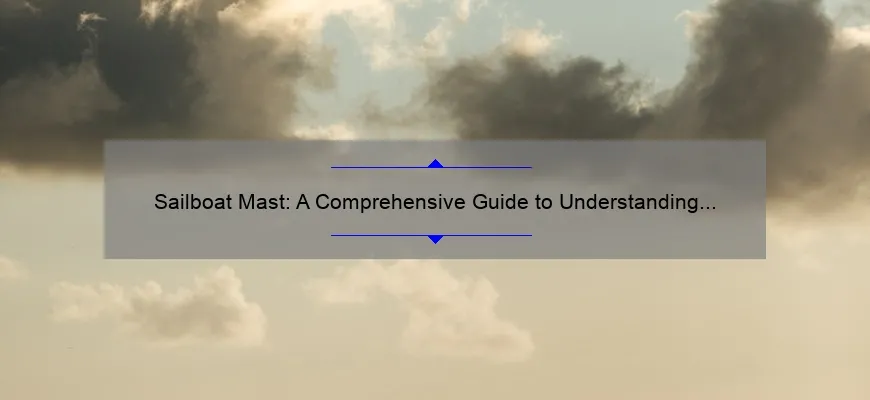
== Short answer: Sailboat mast == A sailboat mast is a vertical pole or spar that supports the sails of a sailboat. It provides structural stability and allows for adjustment of the sail position to effectively harness wind power. Typically made of aluminum or carbon fiber, mast design varies based on boat size, sailing conditions, and intended use.
The Sailboat Mast: A Comprehensive Guide for Beginners
Title: The Sailboat Mast: A Comprehensive Guide for Beginners
Introduction: Ah, the majestic sailboat mast! Like the beating heart of a ship, it stands tall and proud, guiding us through the vast ocean. But what does it actually do? How does it work its magic to harness the power of wind and propel us across water? In this comprehensive guide for beginners, we’ll dive deep into the world of sailboat masts to unravel their secrets and discover why they are indeed a sailor’s best friend.
1. Anatomy of a Sailboat Mast: To understand how a sailboat mast functions, let’s start by dissecting its anatomy. The mast consists of several essential components such as: – Luff track: This vertical groove allows the mainsail to slide up or down smoothly. – Spreaders: These diagonal bars help strengthen and stabilize the mast. – Shrouds and stays: These supportive cables hold the mast in position while also countering sideways forces. – Sheave boxes: Found at strategic points on the mast, these small wheel-like mechanisms assist with hoisting sails or other rigging tasks. By familiarizing ourselves with these various parts, we can appreciate how each plays a crucial role in maintaining balance and stability.
2. Materials Matter: Masts can be constructed from different materials including wood, aluminum alloy, carbon fiber composite, or even stainless steel. While wooden masts exude classic charm, modern technologies have introduced lighter options like carbon fiber that enhance performance and durability. The choice of material depends on factors such as boat size, sailing purpose (racing or cruising), budget constraints, and personal preferences.
3. Setting Sail: Hoisting Techniques Hoisting your sails is an art in itself – a symphony between wind and rigging systems. When raising your main sail, you can rely on either external halyards run externally to pulleys at deck level or internal halyards hidden inside the mast. The former allows for easy maintenance and inspection, whereas the latter provides a sleeker aesthetic appeal. Whichever method you choose, proper hoisting techniques are crucial to avoid tangling or jamming.
4. Sail Control: Mast Dynamics Understanding how the sail interacts with the mast is essential for optimizing performance. Controlling sail shape is achieved through tensioning and releasing various lines such as halyards, cunninghams, and outhauls. These adjustments influence mast bend, which in turn affects the distribution of power and aerodynamic efficiency of your sails. A well-tuned mast ensures efficient sailing in different wind conditions.
5. Stepping Up: Installing a Sailboat Mast Stepping a mast may provoke anxiety among beginners, but fear not! With careful planning and some assistance, it can be an invigorating part of preparing your sailboat for action. From proper alignment to securely attaching shrouds and stays, following step-by-step procedures helps avoid mishaps during this critical process.
6. Maintenance Matters: Regular maintenance extends the lifespan of your sailboat mast while ensuring safety on the water. Frequent inspections for corrosion, cracks, or loose fittings are essential. Additionally, lubricating moving parts like sheaves and checking tension in standing rigging help guarantee smooth sailing adventures.
Conclusion: Congratulations! As you reach the end of this comprehensive guide on sailboat masts, you’ve gained invaluable insights into their anatomy, materials used in construction, hoisting techniques, dynamics correlation with sails – all topped off with stepping tips and maintenance reminders. Now equipped with this knowledge foundation, novice sailors can embark confidently upon their seafaring journeys armed with an understanding of just how crucial the majestic sailboat mast truly is – a steadfast partner harnessing wind power while propelling us towards endless maritime horizons!
How to Choose the Perfect Sailboat Mast for Your Vessel
When it comes to sailing, one of the most crucial components of your vessel is undoubtedly the sailboat mast. It serves as the backbone and lifeline of your boat, allowing you to harness the power of the wind and navigate through the vast open waters. Choosing the perfect sailboat mast is not a decision to be taken lightly; it requires careful consideration of various factors to ensure optimal performance and safety.
Firstly, before delving into the specifics, it’s important to understand that sailboat masts come in different materials, each with its unique set of characteristics. The most common options are aluminum and carbon fiber. While aluminum masts offer durability at a lower cost, carbon fiber masts are lighter and stiffer, providing enhanced performance on the water.
Now let’s embark on our journey to select the ideal sailboat mast for your vessel! The first crucial factor to consider is your boat’s size and weight. A larger, heavier vessel would require a mast with greater strength and rigidity to withstand increased loads from larger sails. On the other hand, smaller boats may benefit from a lighter mast that allows for more flexibility in sail adjustments.
Next up is understanding your sailing goals – are you more inclined towards leisurely cruising or competitive racing? If you’re an avid racer seeking top-notch performance, a carbon fiber mast might be your best bet due to its stiffness and superior response to wind conditions. However, if you prioritize comfort and relaxation during casual sailing trips, an aluminum mast could provide suitable stability without compromising on enjoyment.
Another aspect not to be overlooked is ease of maintenance. Aluminum masts generally require less upkeep compared to their carbon counterparts as they are less prone to damage from UV rays or accidental impacts. Carbon fiber masts demand regular inspection for any signs of wear or stress fractures since they can’t handle excessive bending or compression forces as well as aluminum.
Moreover, think about where you’ll primarily be sailing – will it be in open, unrestricted waters or areas with low bridges and height restrictions? Mast height plays a significant role here. Ensure your chosen mast fits within the clearance limits to avoid any unpleasant surprises during your journeys.
Sailboat masts come in various configurations, including single-spreader, double-spreader, and even triple-spreader setups. The number of spreaders – horizontal struts that help support the mast – affects overall stability and rigging options. Generally, single-spreader masts are easier to handle for casual sailors, while double or triple spreads offer higher performance but demand more meticulous tuning.
Lastly, it’s worth noting that the perfect sailboat mast doesn’t necessarily mean splurging on the most expensive option available. A comprehensive comparison of prices and features from different manufacturers can lead you to an ideal balance between affordability and quality.
At this point in our mast-selection odyssey, you should have a clearer picture of what to consider when choosing the perfect sailboat mast for your vessel. Remember to evaluate factors such as materials (aluminum vs. carbon fiber), boat size/weight, sailing goals (cruising vs. racing), maintenance requirements, clearance restrictions, spreader configuration, and cost-effectiveness.
Now set sail confidently with a mast tailored precisely to meet your vessel’s needs and embark on countless unforgettable nautical adventures! Bon voyage!
Step-by-Step Installation of a Sailboat Mast: A Beginner’s Guide
Are you a sailing enthusiast who has always been fascinated by the graceful movement of sailboats gliding through the water? Do you dream of owning your own sailboat and embarking on exciting adventures in the open sea? If so, then one of the essential skills you need to acquire is how to install a mast on a sailboat. In this beginner’s guide, we will walk you through the process step-by-step, ensuring that even if you have never done it before, you will be able to tackle this task with confidence and expertise.
1. Tools and Preparation: First things first – gather all the necessary tools for the job. You will need a crane or hoist (if available), a torque wrench, mast wedges, shims, sail track lubricant, an adjustable wrench or socket set, and plenty of patience! Before starting the installation, ensure that both your boat deck and mast are clean and free from dirt or debris.
2. Preparing the Mast Step: The mast step is where your mast rests on your boat deck. Start by inspecting it thoroughly for any damage or wear that may compromise its integrity. If needed, reinforce or repair it before proceeding further. Place mast wedges under the front part of the mast step to act as support when installing.
3. Attach Necessary Fittings: Now it’s time to attach various fittings onto your mast which are crucial for rigging control lines and sails effectively. These include halyard sheaves (for raising and lowering sails), spreader brackets (providing horizontal support), and any other attachments specific to your sailboat model.
4. Hoisting with Precision: Here comes the exciting part – hoisting your sailboat mast into position! Ideally, use a crane or hoist designed explicitly for this purpose so that you can easily control its vertical movement while minimizing the risk of damage. Carefully guide the mast toward the mast step, ensuring it is centered and aligned correctly.
5. Adjusting for Precision: Once your mast is in place, it’s time to make fine adjustments to ensure its vertical alignment. Use shims or wedges as necessary to eliminate any gaps between the mast and mast step. This step is crucial as it ensures that your sailboat will perform optimally on the water without any unnecessary stress on either the mast or your rigging.
6. Securing with Confidence: Now that your mast is perfectly aligned, it’s time to secure it in place. Start by cautiously tightening the bolts on each side of the base using an adjustable wrench or socket set. Remember not to overtighten, as this can potentially damage both your boat and mast. Once done, check all fittings once again and confirm they are securely attached.
7. Lubrication for Smooth Sailing: To ensure flawless movement of your sails along the track, apply a suitable sail track lubricant generously over your sail track after installation while closely following manufacturer guidelines. This lubrication will minimize friction when hoisting or lowering sails, resulting in a smoother sailing experience overall.
Congratulations! You have successfully installed a sailboat mast from start to finish! By following these step-by-step instructions with patience, attention to detail, and our witty guidance, you have gained valuable knowledge that will enable you to embark on countless sailing adventures confidently.
However, always remember that safety should be your number one priority whenever working with equipment related to sailing vessels. If at any point you feel unsure or overwhelmed during this installation process, do not hesitate to seek professional assistance from an experienced sailor or marine technician who can offer guidance specific to your sailboat model.
With newfound expertise in installing masts and pursuing many thrilling sea voyages ahead, set forth with confidence into uncharted waters – bon voyage!
Common FAQs about Sailboat Masts Answered
Sailing enthusiasts often find themselves captivated by the majestic beauty of sailboats gliding through the water. One key component that allows these vessels to harness the power of wind is the sailboat mast. However, many individuals who are new to sailing may have questions about masts and their importance in sailing. In this blog post, we aim to provide detailed and professional answers to some common FAQs about sailboat masts while injecting a touch of wit and cleverness along the way.
1. What is a sailboat mast? Ah, the central pillar of sailing prowess! A sailboat mast is essentially a vertical structure that stands tall and proud on a vessel, supporting the sails and imparting stability to your seafaring adventure. Think of it as the backbone upon which your nautical dreams come to life!
2. Why is choosing the right mast crucial for efficient sailing? Picture this: you’re in command of your trusty sailboat, ready to conquer the sea’s vast playground. But alas! Your hasty choice of an ill-suited mast has left you floundering like a fish out of water! The right mast offers optimal rigidity, balance, and strength necessary for efficient navigation regardless of wind conditions or sea state.
3. Aluminum or carbon fiber? Which material reigns supreme for masts? Ah, here lies one’s decision-making predicament! Does one opt for aluminum – sturdy like an old lighthouse but slightly heavier? Or does one embrace carbon fiber – lightweight as an albatross feather yet remarkably robust? Both materials have their merits; therefore, choosing between them boils down to personal preference and intended usage.
4. Can I upgrade my existing mast without breaking the bank? Fear not, fellow mariner! While pursuing that luxurious upgrade might conjure images of treasure chests filled with gold doubloons disappearing into Davy Jones’ locker, there are cost-effective options available. Opt for used masts in good condition, or explore local sailing communities where fellow sailors may be willing to part with their old but serviceable masts.
5. How can I ensure proper maintenance of my sailboat mast? Ahoy, matey! Maintenance is the key to keeping your mast shipshape and preventing any unwanted surprises on your voyage. Regular inspections for cracks, corrosion, or loose fittings are akin to swabbing your deck – tedious yet necessary. Additionally, ensuring proper storage and protecting your mast from harsh elements will keep it standing tall through the test of time!
6. Can a damaged mast be repaired or must it walk the plank? Nay, despair not as all hope is not lost! In cases of minor damage like small cracks or dings – worry not! Reliable craftsmen specializing in mast repairs can work their magic and have your trusty companion primed to conquer the waves once more. However, in more severe instances of structural compromise, replacing the mast might be the only option left.
7. How do I decipher the mysterious language of sailboat mast measurements? Approach ye with careful study, for understanding these mystifying dimensions requires an astute mind! Height measured from deck to tip (known as height aloft), length along its backside (called luff measurement), and even diameter play a significant role in determining compatibility with your vessel’s rigging system. Consult experts fluent in this ancient tongue to avoid any discrepancies on your nautical journey!
In summary, sailboat masts are no mere aesthetic addition; they are essential components that provide stability and sailing prowess to vessels at sea. Choosing the right material and maintaining them diligently ensures smooth sailing adventures without scuppering one’s budget. So set your sights high, dear reader, for these answers shall guide you towards a more enlightened understanding of sailboat masts!
Important Factors to Consider When Maintaining Your Sailboat Mast
Sailing is a thrilling and invigorating experience that allows us to connect with nature, challenge ourselves, and explore the vast open waters. However, as with any adventure, there are certain aspects that we must pay close attention to in order to ensure a safe and successful voyage. One such critical component of a sailboat that demands careful maintenance is the mast. The mast serves as the backbone of your vessel, providing structural integrity and supporting your sails. In this blog post, we will delve into some important factors to consider when maintaining your sailboat mast.
Structural Integrity: The first and foremost factor that you need to consider when maintaining your sailboat mast is its structural integrity. Any signs of damage or wear and tear should not be taken lightly, as it can compromise the overall stability and safety of your vessel. Regularly inspecting your mast for any cracks, dents, or corrosion is crucial to identify any issues early on before they escalate into major problems. Additionally, keep an eye out for loose or rusted fasteners and make sure all connections are secure.
Rigging Wear: Another vital aspect of keeping your sailboat mast in top condition is paying attention to its rigging components. Rigging includes various cables, wires, and ropes responsible for controlling the sails’ position and tension. Over time, these elements can experience significant wear due to exposure to sun, saltwater, intense winds, or simply general usage. To maintain rigging longevity and ensure safety while sailing, regularly examine all parts for fraying strands or broken wires. Furthermore, proper tensioning of rigging should be maintained as per manufacturer recommendations.
Cleanliness: Maintaining a clean sailboat mast may sound like an obvious consideration but is often overlooked by many boat owners. A dirty mast not only affects the aesthetics but can also lead to performance issues if left unattended for too long. Accumulated dirt, grime, salt deposits or marine growth can create unwanted drag, hindering the sailing experience. Regular cleaning with mild soapy water and a soft brush is generally sufficient to remove stubborn stains and prevent corrosion.
Painting: Maintaining the aesthetic appeal of your sailboat mast should also be on your priority list. A fresh coat of paint not only enhances its appearance but also offers added protection against corrosion. Prior to painting, ensure that the mast is thoroughly cleaned and all rust or peeling paint is removed. Use a high-quality marine-grade paint specifically designed for aluminum or wooden masts, depending on the material of your sailboat’s mast.
Inspections: Performing routine inspections by a professional is an essential factor in maintaining your sailboat mast. It is recommended to have an experienced rigger thoroughly inspect your mast at least once a year, or more frequently if you actively engage in competitive racing or regularly navigate harsh conditions. These experts have the knowledge and expertise to identify potential weaknesses that may go unnoticed by untrained eyes, providing peace of mind and preventing any unexpected mishaps on your sailing journeys.
In conclusion, maintaining your sailboat mast requires careful attention to detail and regular inspections. By prioritizing factors such as structural integrity, rigging wear, cleanliness, painting, and professional inspections, you can ensure that your vessel remains in excellent condition for countless captivating voyages ahead. So set sail with confidence knowing that you’ve taken every measure to maintain this vital component of your beloved sailboat!
Discover the Different Types of Sailboat Masts and Their Advantages
Sailing is an activity that combines the thrill of speed with the serenity of the open water. One crucial component of any sailboat is the mast, which not only provides structural support but also plays a vital role in determining a boat’s performance and handling characteristics. To help you dive deeper into this fascinating world, we will explore the different types of sailboat masts and highlight their advantages.
1. Fractional Masts: Let’s start with fractional masts, which are one of the most common types found on sailboats today. As the name suggests, these masts divide the rig into two sections: upper and lower. The ratio of the length between these sections can vary, offering flexibility depending on sailing conditions and desired performance.
Advantages: – Versatility: Fractional masts allow for fine-tuning your sails by adjusting halyard tension or configuring additional stays. – Better control in strong wind conditions: The longer lower section provides stability and prevents excessive heeling (tilting) usually encountered during high winds. – Improved balance: By placing more weight aloft, fractional masts offer better balance when tacking (changing direction against the wind).
2. Masthead Masts: In contrast to fractional masts, masthead masts have their forestay attached at or near the masthead rather than a fraction down its length. Traditionally seen on older cruising boats, they offer distinct advantages for particular sailing styles.
Advantages: – Strong downwind performance: With their design allowing for larger headsails like genoas or asymmetrical spinnakers, masthead rigs excel in reaching or downwind courses. – Easy to balance for autopilot usage: Due to a greater proportionality between mainsail area and foresail area when compared to fractional rigs, mastheads tend to require less manual adjustment while under autopilot control.
3. Keel-stepped vs Deck-stepped Masts:
3.a. Keel-stepped Masts: Keel-stepped masts are secured and supported by the boat’s keel, extending through the deck to connect with it at the base. This type of rig is commonly found on larger sailboats designed for offshore sailing.
Advantages: – Superior strength: The keel provides excellent support for the mast against heavy loads encountered during rough weather conditions. – Reduced deck compression: By transferring the load directly to the keel, stress on the deck is minimized, ensuring a longer-lasting and more reliable structure overall.
3.b. Deck-stepped Masts: Deck-stepped masts sit on top of a sailboat’s deck, rather than being connected directly to the keel. Typically seen on smaller boats and cruising vessels, they have their own set of advantages.
Advantages: – Easier maintenance: With no penetration through to the hull like keel-stepped masts, maintaining or replacing deck fittings becomes less complicated. – Cost-effective construction: As there is no need for precision alignment with a keel box, constructing a boat with a deck-stepped mast can reduce building costs. – Adjustable height: Deck-stepped masts offer flexibility in terms of adjusting their height based on clearance requirements for bridges or overhead obstructions.
Understanding these various types of sailboat masts empowers sailors to make informed choices when selecting or upgrading their vessel’s rigging. Each mast type brings its own set of advantages that can significantly impact your sailing experience depending on different conditions and preferences.
Recent Posts

- Sailboat Gear and Equipment
- Sailboat Lifestyle
- Sailboat Maintenance
- Sailboat Racing
- Sailboat Tips and Tricks
- Sailboat Types
- Sailing Adventures
- Sailing Destinations
- Sailing Safety
- Sailing Techniques

Understanding the Different Parts of a Sailboat
by boatshowhou | May 22, 2014 | Blog | 3 comments

Have you ever thought about learning how to sail? If so, then you should start by understanding the different parts of a sailboat if you want to sail your boat as efficiently as possible. Here they are in alphabetical order:
- Block: This is the nautical term for a pulley.
- Boom: The horizontal support for the foot of the mainsail which extends aft of the mast. This is what you want to watch out for when changing directions in a sailboat. It can give you quite a wallop on the head if it hits you.
- Bow: This is what the front of the boat is called.
- Centerboard: This is a (usually fibreglass) plate that pivots from the bottom of the keel in some boats and is used to balance the boat when under sail.
- Cleat: Cleats are what lines (or ropes) get fastened to when they need to be kept tight.
- Halyard: Lines that raise or lower the sails. (Along with the sheets, aka running rigging.)
- Hull: The hull is the body of the boat and consists of everything below the deck.
- Jib: This is the sail at the bow of the boat. The jib helps propel the boat forward.
- Genoa: A foresail which is larger in size than a jib.
- Keel: The keel is what prevents a boat from sliding sideways (“making leeway”) in whatever way the wind is blowing and stabilizes the boat.
- Line: Lines are ropes. They are everywhere on boats. There is only one “rope” on a sailboat, the bolt rope which runs along the foot of the mainsail.
- Mainsail: As the name implies, this is the main sail of the boat. It is the sail attached to the back of the mast.
- Mast: The mast is a large, vertical pole that holds the sails up. Some boats have more than one mast.
- Painter: This is a line positioned at the front of small boats. It is used to tie the boat to a dock or another boat.
- Rudder: The rudder is how the boat is steered. It is moveable so that when you turn the wheel or tiller, the rudder directs the boat in the direction you would like the boat to go.
- Sheets: The lines that control the sails. (aka running rigging.)
- Spinnaker: The usually brightly colored sail used when sailing downwind or across the wind.
- Stays and Shrouds: There are wires that make sure the mast stays upright, even in very heavy winds. (aka standing rigging.)
- Stern: This is the term for the back of the boat.
- Tiller: The tiller is a stick attached to the rudder and is used to control the rudder.
- Transom: This is what we would call the butt of the boat. It is the back part of the boat that is perpendicular to its centerline.
- Wheel: The wheel works the rudder, steering the boat.
- Winch: Winches help bring in the lines. When lines are wrapped around a winch, a sailor can turn the winch with a handle, which will make it easier to bring in the lines.
Ready to learn how to sail? There are great sailing classes that you can take right here close to home! One of them is in Seabrook called 3D Coast Captains – check them out – they’ll be at the June Boat Show along with other exhibitors !
Follow Us: Facebook – Foursquare – Twitter – YouTube – LinkedIn
What does the sails actually do on a sailboat
Sails are an air foil like an airplane wing in that the wind flowing over the front and under the back of the sail forms a low air pressure in front of the sail and a higher pressure area behind the sail. This pulls the sail and thus the boat forward through the water. The sails are also used to turn the boat and they can be eased or released to slow or stop the boat.
What does the sails on a sail boat do
Submit a Comment Cancel reply
Your email address will not be published. Required fields are marked *
Sign up for an account
Already have an account? Log in
Login to continue
Don't have an account yet? Sign Up
Forgot your password?
Log in | Sign Up
Parts of a Sailboat
Published on 11/26/2020 by Charles Gendron
Every part to a sailboat has a name, and sometimes, even a few names. Learning the parts of a sailboat will come naturally the more you sail. Knowing the parts is not required in order to learn how to sail, although it does help.
The following is a detailed diagram of a sloop, due to popularity, and a list of all sailboat parts accompanied by the diagram to go along with the part.
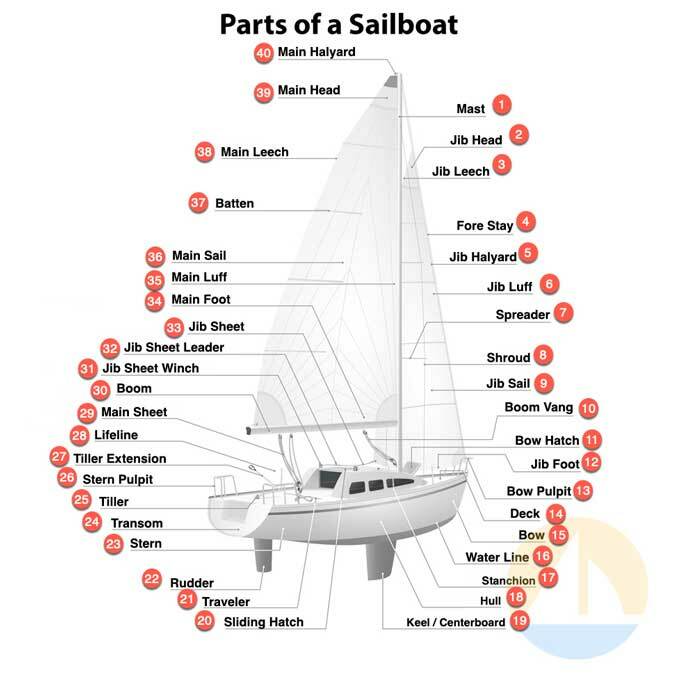
1. Mast – A durable vertical pole, which is one of the main structural components of a sailboat, that holds up the sails, provides stability and gives the sailboat its height.
2. Jib Head – The top area of the jib that includes a ringhole to allow connection to the jib halyard which attaches to the top of the mast.
3. Jib Leech – The back edge of the jib sail, which runs from top to bottom vertically.
4. Fore Stay – A key component of the standard rigging, located in the forward most part of the boat, holds the mast up and keeps it from falling backwards.
5. Jib Halyard – A line that runs up through the mast that connects to the jib head and hoists up the jib sail.
6. Jib Luff – The forward edge of the jib sail that slides into the luff track along the fore stay, keeping the jib securely in place.
7. Spreader – Horizontal spokes that stick out from the mast on opposite ends to “spread” or keep the shrouds stabilized.
8. Shroud – A strong metallic wire located on both the starboard and port side deck that helps keep the mast secured in place.
9. Jib Sail – The sail located forward of the boat.
10. Boom Vang – Keeps the boom from rising when the main sail is luffed which ensures proper shape of the sail.
11. Bow Hatch – A secure opening in the deck located forward (in the bow) of the boat that allows for fresh air into the cabin.
12. Jib Foot – The bottom edge of the jib sail that runs horizontally from the tack to the clew.
13. Bow Pulpit – A protruding slab on the bow of the boat that secures the anchor in place, allowing the anchor to easily move up and down safely away from the hull.
14. Deck – The top section of the sailboat, very strong and sturdy, that encloses the hull. When inside the cabin, the deck serves as a roof.
15. Bow – The most forward section of the sailboat, including the area of both the deck and hull.
16. Water Line – The point at which the paint on the bottom side of the hull ends which signifies the bottom portion of the hull that rests under the water.
17. Stanchion – A vertical spoke along the outer edge of the deck that holds up the lifelines.
18. Hull – The lower outer half of the sailboat that makes up everything except the deck.
19. Keel / Centerboard – A fin below the sailboat’s hull that provides stability, typically made out of lead, that consist of about 1/3 the total weight of the sailboat.
20. Sliding Hatch – A secured doorway, typically made out of wood, glass or fiberglass, that slides over the access area to the cabin.
21. Traveler – A pully device/system located either in the cockpit or above the cabin top that helps trim the main sail
22. Rudder – A rotatable fin below the hull in the very aft of the boat. Either a tiller or a wheel system is connected to the rudder in which steers the sailboat.
23. Stern – The back section of the sailboat, opposite of the bow.
24. Transom – The backside of the sailboat, above the waterline, that adjoins the stern and the hull. In newer model sailboats, the transom is able to fold up and down to serve as platform.
25. Tiller – A long wooden arm attached to the rudder used to steer the sailboat. (Note: Sailboats are either installed with a tiller or a wheel for steering)
26. Stern Pulpit – A metal railing, that sometimes is shaped to include a seat, in the stern (back) of the boat to provide extra safety from falling overboard.
27. Tiller Extension – A metal bar that attaches to the tiller in order to give the helmsman greater ability to steer from other positions in the cockpit.
28. Lifeline – A strong metal cable rapped in a rubber coating that runs through the stanchions along the deck’s edge to provide safety to the crew. Helps prevent man overboard.
29. Main Sheet – An adjustable line used to control the main sail’s angle of attack (to the wind).
30. Boom – A long pole like object, which holds and provides support to the main sail, that connects to the mast at a 90 degree angle.
31. Jib Sheet Winch – An instrument located on both the port and starboard side that enables the helmsman to adjust the luff of the jib by pulling on the sheet (line) that leads to the jib sail.
32. Jib Sheet Leader – A permanent ring, in which the jib sheet passes through, attached to the deck that secures the jib sheet in place.
33. Jib Sheet – A line of rope attached to the clew of the jib that runs all the way back to the cockpit into a winch.
34. Main Foot – The lower bottom edge of the main sail that connects to the boom.
35. Main Luff – The inner edge of the main sail that connects to the mast.
36. Main Sail – The sail that is rigged to the main mast and boom.
37. Batten – Cloth like material hanging off the luff of the main sail to show airflow.
38. Main Leech – The back curved edge of the main sail.
39. Main Head – The top-most section of the main sail where it connects to the main halyard.
40. Main Halyard – A sheet (line), used to hoist the main sail up and down, that runs from the cockpit, up through the main mast and connects to the head of the mainsail.
Post Your Sailboat for Sale!
- Inquire Now
- YACHT SEARCH
- Motor Yachts
- Sailing Yachts
- $1 – $25,000 Yachts
- $26,000 – $50,000 Yachts
- $50,000 – $100,000 Yachts
- $101,000 – $200,000 Yachts
- $200,000 – ∞ Yachts
- Virgin Islands
- Leeward Islands
- Turks and Caicos
- Spain & Balearic Islands
- New England
- Tahiti & South Pacific
- More destinations
- Charter Advice
Learning the Parts of a Sailboat
Teach yourself the definitions of the many different sailboat parts.
A sailboat is a boat that is propelled either partly or entirely by sails. Sailing is popular in many destinations around the world. For example, Bahamas catamaran charters are a time-honored tradition in the Caribbean, and in the Mediterranean, sailing is a way of life.
There are several different types of sailboats and what constitutes a sailboat varies by maritime culture and region. Most sailboats are classified based on their hull configuration, size, purpose, keel type, configuration and number of masts, and the sail plan. The different types of sailboats include cutters, catboats, dinghies, ketches, schooners, sloops, and yawls. There are many different parts that make up a sailboat. Continue reading to learn about the different parts of a sailboat.
- Backstay – A rod or cable that runs from the stern of the boat to the top of the mast.
- Block – This is the nautical term that means pulley.
- Boom – A pole that attached to the mast horizontally and is used for extending the foot of the mainsail.
- Boom Vang – A device used for holding down the boom.
- Bow – The front part of a boat.
- Centerboard – A plate that pivots and is used to lessen leeway and balance the boat.
- Cleat – A fastening where lines are able to be secured.
- Halyard – The line that is used to raise a sail; the main halyard raises the main sail.
- Hull – This is the body of the boat, not including masts, superstructure, or rigging.
- Jib – A foresail that fits within the foretriangle and the clew does not extend past the mast.
- Keel – The part of a boat that is fixed underwater and is used to provide stability and prevent drifting sideways.
- Line – Refers to any pieces of rope located on a boat.
- Mast – A vertical pole on a boat that is used for supporting sails.
- Outhaul – A sail control that allows tensioning of the foot and attaches to the clew.
- Painter – The line attached to a smaller boats bow that is used for tying it to another boat or a dock.
- Rudder – The movable underwater steering device of a boat.
- Shackle – A fitting composed of metal that is normally used to connect halyards and sails.
- Shrouds/Stays – Wires that help to hold the mast upright; the front wire is referred to as the forestay.
- Spreade r – Struts used to increase the power of the shrouds, they are attached to the mast.
- Stern – The afterpart of the boat.
- Tiller – A metal or wooden stick that is used to turn the rudder of the boat.
- Transom – The afterpart of the boat that is square to its centerline.
- Wheel – The apparatus used for steering.
- Winch – A drum shaped object made of metal which lines are wrapped around to make trimming easier.
There are many different parts of a sailboat that work together to help the boat move. Learning how to sail can be fun and the first step is becoming familiar with the parts of a sailboat and commonly used sailing terms. If you’re planning a yachting vacation – like a Bahamas yacht charter – this knowledge will come in handy, if you’d like a sailing lesson at sea. For more on sailboat parts and sailing terms, check out the pages below.
- In-Depth Page of Sailing Terminology
- The Basic Parts of a Sailboat
- Definitions and Mnemonics for Sailors and Powerboaters
- Learn the Parts of a Sailboat
- Sailing Terms Everyone Should Know
- Sailing Basics: Terms, Rules, and How to Sail
- Nautical Terms Related to Sails and Sailing
Written by Katja Kukovic
Go to Knowledgebase
Set your search criteria to find the perfect yacht
- Alaska Australia Bahamas BVI Caribbean Croatia Florida France Galapagos Greece Indonesia Italy Malaysia Maldives Mexico Mediterranean New England Norway Spain Thailand Tahiti Turkey
- Motor Yacht Catamaran Sailing Boats
- 2 4 6 8 10 12 12+
Search by yacht name
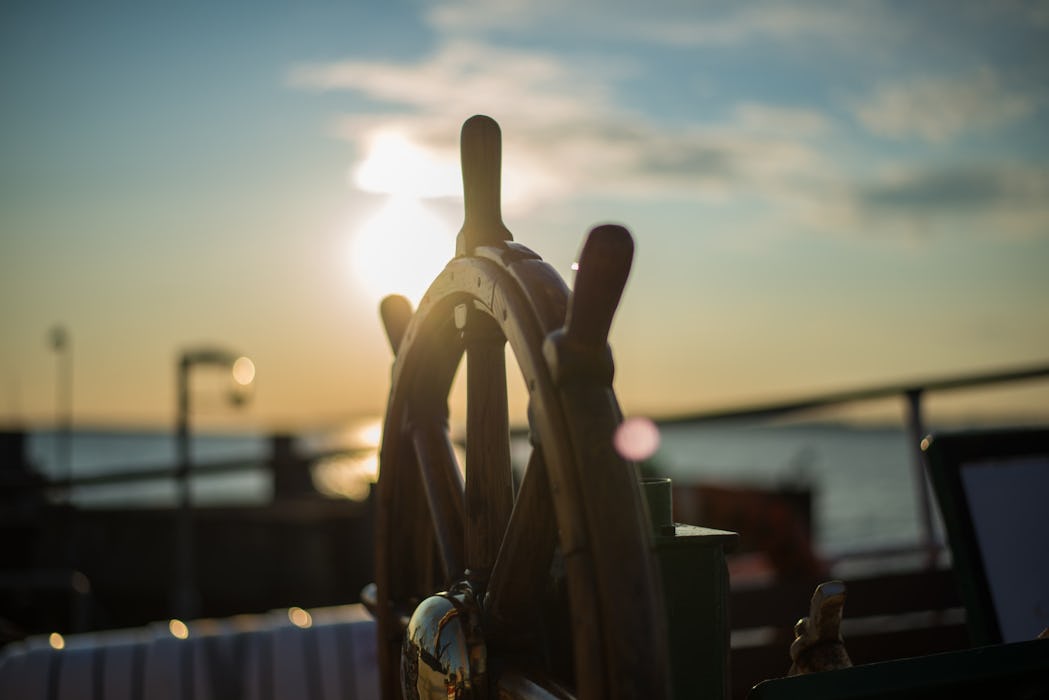
Parts of a ship explained

COVID 19: You can change your booking on most of our boats if your travel plans are affected by coronavirus. See here for more details
Let us help you plan the perfect sailing trip
Provide your travel details, receive free offer and enjoy your holiday!
What are the sides of a ship called?
THE FRONT of the ship is called the bow , and THE BACK of the ship is called the stern .
When looking towards the bow, THE LEFT SIDE is called the port side , and the right side is called the starboard .
But to really get to know the vessel you will spend your holidays on, you should learn a little something about the parts. Here is an alphabetical ”everything you have to know about ships” guide.
- ANCHOR – A chain with a hook on the end that falls to the bottom of the sea and prevents your yacht from sailing off without you. Used for parking your yacht in a bay.
- ANCHORAGE – A great spot for holding, anchoring and sheltering your vessel
- BACKSTAY – A steel wire attached to the back of the boat
- BEAM – The width of the vessel.
- BOW – Bow of a ship is the front of a vessel. A simpler term would be the pointy end of the boat.
- BOAT – A boat is a vessel small enough to be carried by another vessel. When a boat is no more possible to be transferred by another it is called a ship.
- BOAT HOOK – A pole with a hook. You use it to grab and pick up a rope, collect something that has fallen overboard, or push the vessel off the port.
- BOOM – A horizontally set pole that holds the bottom of the sail. Not a pleasant experience having this hit you in the head.
- BURGE – A distinguishing flag to identify a recreational organisation of the vessel.
- CABIN – A part of the vessel below the deck where you can sleep, spend time and relax.
- COCKPIT – A place in a boat from where you (or the captain) controls the boat. It is usually an open space outside the cabin.
- CLEAT – Metal fittings you use to fasten a rope.
- DECK – An area of the vessel that covers the hull. The part where you spend most of the time.
- DRAFT – The difference between the lowest point of the boat and the waterline.
- FENDERS – Cushions made out of rubber or plastic to prevent damage to the vessel.
- FORESTAY – A steel wire attached to the bow of the boat. The other side of the backstay.
- GALLEY – A vessel’s kitchen.
- GRAB RAILS – Rails you should grab when feeling like you might fall off.
- GUNNEL/ GUNWALE – The rail that goes along the edge of a vessel.
- HATCH – An opening in the vessel’s deck with a water-resistant cover.
- HELM – A wheel or a tiller that controls the vessel. One of the most important things on a vessel!
- HULL – The shell and the main part of a vessel, the floating part.
- IRON MIKE – A slang name for auto-pilot
- JACOB’S LADDER – The type of rope ladder that you’d use to climb up something. It can be lowered from the deck when passengers come on board.
- JIB – The triangular sail at the front of the vessel.
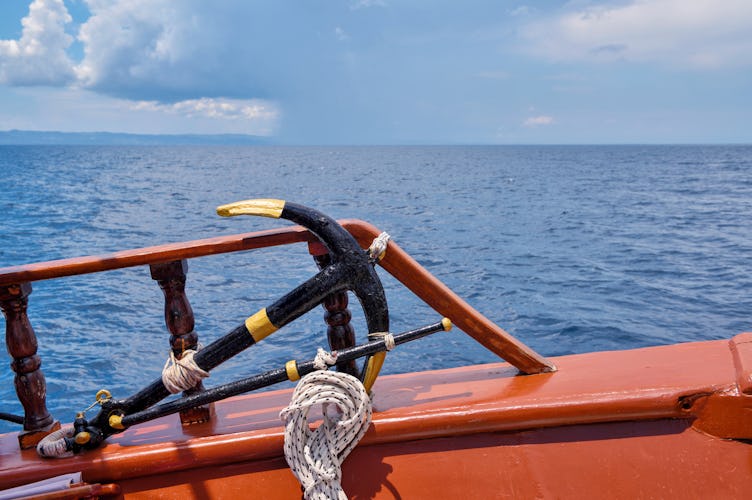
- KEEL – The structural base and the lowest point of the boat's hull, the backbone of a vessel.
- LINE – a general term for a rope on a vessel. It is a good thing to know how to tie knots when working with the lines (ropes).
- MAINSAIL – The sail behind the main mast of the vessel.
- MAST – The vertically set pole that supports the sail.
- MOORING – Mooring a vessel means fastening it so it can not go adrift. It also includes all sorts of locations a vessel can be moored on such as a pier, a wharf or something else.
- PORT – The left side of the vessel.
- PROW – A poetical term for the front of the boat.
- RIGGING – The ropes and wires that control the sails and support the masts.
- RUDDER – vertical plate or a board used to steer the vessel connected to the back.
- SAILS – An eco-friendly engine that converts wind power into boat speed. The most important part for sailing.
- SALOON – The living area in the vessel, you can go here to relax.
- SCUPPERS – The holes in the deck that let the water drain out and control the level of the vessel.
- SEA COCK – A faucet in the hull that can be turned off when not in use.
- SHIP – A vessel predominantly used for oceangoing travels.
- SKIPPER – The most important person on the vessel, the person in charge and responsible for the safety of all men aboard.
- SPRING LINE – This is a rope that stops a boat from moving forward or backward while being fastened to a dock.
- STARBOARD – Starboard is the right side of a vessel when looking towards the front/bow
- STEM – The front of the vessel. Also known as the bow.
- STERN – The back of the vessel. The stern of the ship is the opposite of the bow.
- STERN LINE – This is a rope leading from the stern (back) of the vessel.
- SUPERSTRUCTURE – Everything above the deck.
- TILLER – A tiller is a bar or handle that you use to turn a vessel’s rudder to change directions.
- TOPPING LIFT – A line (rope) used to hold the boom (a horizontal pole that holds the bottom of the sail) up when the sail is lowered.
- TRANSOM – The transom is a wall at the back of a vessel.
- UNDERSIDE – The area of the vessel that touches the sea. The bottom of the vessel.
- VESSEL – A craft made for traveling on water, usually a larger boat or a ship
- WINCH – A rotating drum powered either by electric motor or human motion
- AROUND THE SAILING WORLD
- BOAT OF THE YEAR
- Email Newsletters
- America’s Cup
- St. Petersburg
- Caribbean Championship
- Boating Safety
- Ultimate Boating Giveaway

Downwind Under Jib and Main
- By Ed Baird
- Updated: September 8, 2020
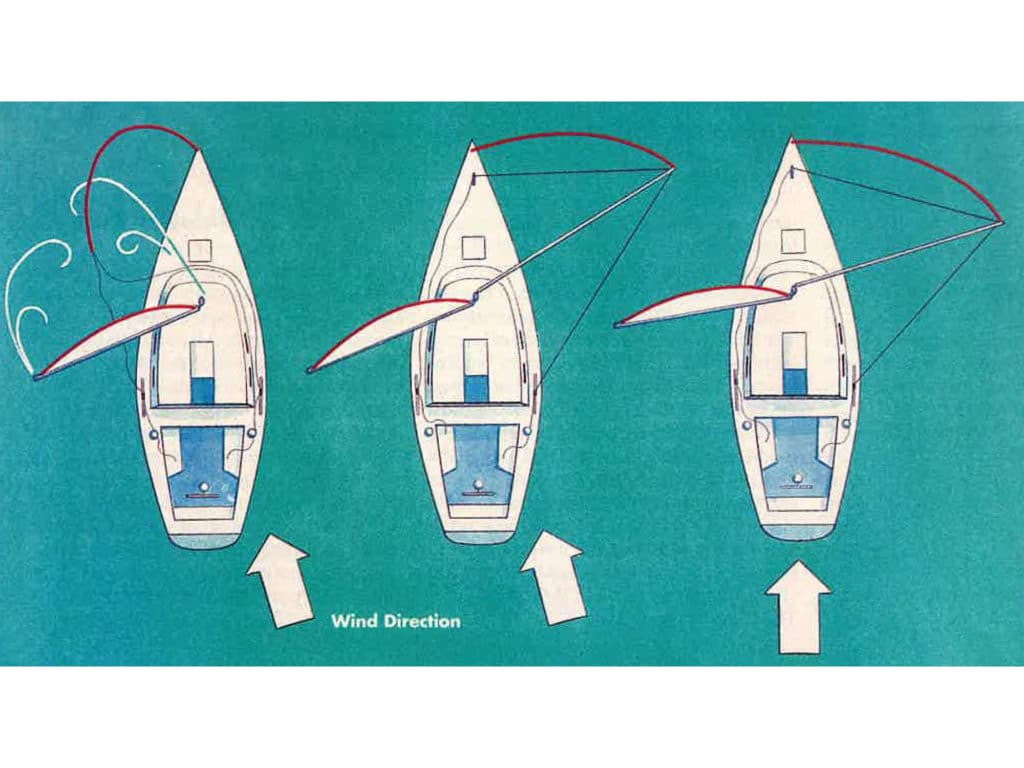
Non-spinnaker divisions in distance races and jib-and-main evening races represent a growing segment of sailing. Sailors enjoy the simplicity of jib-and-main racing because it doesn’t require a big crew or a lot of expensive gear. There are more and more races that now include non-spinnaker divisions so that a broader range of sailors (and a bigger fleet) can compete. Obviously, this breeds a whole new set of performance questions for getting downwind. A boat sailed correctly can make huge gains in a short time — the kind of situation we all daydream about — so it’s really worth working on.
As most boats turn downwind, past the tight-reaching angles and into the broad reach and running apparent-wind angles, a tremendous loss of power is felt. What’s happening, aside from an associated drop in apparent windspeed, is that the wind flow across the main and jib does not stay attached as far aft, leaving the sails stalled. The boat is meant to be using a spinnaker.
But with jibs and genoas only, you’re stuck. You can try to keep the telltales flowing by moving the leads forward as you sail a broader angle, but eventually the sail gets too round and much of it stalls. Circulation around the main is better because you can use the vang to maintain shape, but the main alone won’t give you the speed you need. Also, as you ease the main it steals the wind from the genoa, and the genoa leech gets too close to the main and slows the airflow there. This is not a fast situation!
The Mighty Whisker Pole
Enter the whisker pole. Cruisers and passage makers have long known the value of sailing wing-and-wing and have learned to appreciate the stability of using a pole to keep the jib to windward. Likewise, Snipes and other dinghy classes hold the jib clew out to windward on a pole in lieu of adding spinnakers to their class-prescribed sail arsenal.
You’ll often find your jib wanting to cross over to windward on its own when you’re running. Letting it cross over, in fact, forcing it there, is a lot faster if done properly. When you put your jib or genoa on a pole out to windward, you reverse airflow across it and expose it to air that is undisturbed by the main. By pulling the pole aft you can get the sail into a flatter configuration with normal airflow over both sides along most of the sail. This gives the sail power again and your boatspeed will jump up.
On larger boats, a spinnaker pole will work in this situation, but an adjustable whisker pole is better as its length can be adapted for different wind angles and different-sized sails. Most fleets allow whisker poles to be extended to at least the length of the boat’s J dimension (from the front of the mast to the bow), but you should check the rules for your local fleet. Some fleets allow poles as long as 1.5 times J — a big advantage on a tighter reach, especially if you have an overlapping headsail.
The idea here is to set the sail with proper power (the right amount of depth), and trim it aft until the leech curls back toward the boat. At this point, just as with proper spinnaker trim, you’re getting the most lift and the best speed out of the sail.
This isn’t startling to most readers, but you might run into problems deciding when to pull the headsail over to windward, and knowing exactly how to set it up when it gets there. To make these decisions simpler, let’s first look at how the boat feels when it needs the boost of sailing wing-and-wing.
The first clue that the sail needs wind is when the headsail sheets go limp, meaning the airflow has been greatly reduced and the sail isn’t generating any power. To get more power, you can head up, refilling the sail with wind and building speed, or wing the headsail out to windward on the pole if staying low is necessary to get to the mark. There’s usually an overlap of angles where the jib can work on either side, and you don’t have to wait until the genoa sheet is hanging in the water to know that it’s time to pole out the jib.
When the jib is out on the whisker pole, it’s generally more efficient than when it’s trimmed to leeward, so your tendency should be to get it out there right away. But to be safe and also to keep your tactical options open (it’s tough to luff another boat when you have your jib on a pole to windward), you need to be sure there’s a real opportunity for improvement before going for the pole.
Sailing by the Numbers
Take a look at the accompanying chart. You can develop some general strategic assumptions from this information: When it’s windy and the boat is traveling at close to hull speed, struggling to set the genoa to windward probably won’t help you until you’re way off the wind, say 150 degrees apparent. When it’s really choppy and rough, you should probably postpone setting the pole a little longer too, as it would be hard to keep the sail from collapsing as your boat rolls around in the waves. In lighter winds, getting the genoa across when the wind is 90 degrees apparent (if you have a long enough pole), and aft of that, will help keep your boatspeed up.
The key to making the decision to wing the jib is to know what your speed should be. Every boat has an optimum speed for every point of sail. Velocity prediction programs generate polar diagrams for your boat that will show you how fast you should be going at given angles to the wind and windspeeds. These charts are quite common, and are available through the designer or manufacturer of your boat, or through US SAILING.
If you really want to max out your off-wind speed, a practice session with polar information in hand and a few quick tests at different apparent-wind angles with and without the headsail to windward should give you some hard data to work with in future races. Cruising-canvas polars don’t automatically assume you ‘II be using a whisker pole at the broader angles, so through a little experimentation you can develop your own quick-reference chart and keep it on deck to help take the guesswork out of when to set the pole, and how fast you should be going. If you can show in practice that you can get closer to your target speeds with the pole out at a particular wind angle, your team can be ready to set the pole when you reach that angle in the next race.
Setting the Pole
You should also practice how to use the whisker pole. I believe the best whisker poles are the infinitely adjustable ones, as opposed to those with pins and stops that set the length. Being able to change the length of the pole with an internal purchase system makes it easier to adjust the sail for any wind angle.
During practice, the pole needs to be marked for two lengths that fall within the rules for your fleet: Longer for close reaching, shorter for broad reaches and runs. When you decide to pull the sail across to windward, put the lazy (windward) headsail sheet into the outboard jaw, then extend the pole, and attach it to the mast. Have the helmsman steer low for a short time to relieve some of the pressure on the sail, then ease the leeward sheet, and trim in the windward one.
A word of warning: With the sail out to windward, terrific pressure can be developed on the pole in strong winds or if sailing close-wind angles. Some whisker poles aren’t built to withstand the pressure that a reaching course in strong winds can place on them, and could break or jump off the mast causing damage or injury. If it’s that windy, it would be just as fast to have the headsail trimmed to leeward anyway, so be smart and avoid situations that will put your pole under these loads.
On broader angles, as you trim the pole back it will tend to lift up as the sail fills. Then it will want to bounce up and down in puffs and as the boat goes over waves. A quick fix for this, which is especially nice on boats with limited hardware, is to loop the leeward sheet around the front side of the bow cleat. When you’ve brought the pole back to the position you like, tighten up the leeward sheet and use it as a downhaul. Of course, if you’re on a long leg and have the proper equipment, a real foreguy should be rigged. But this technique is great for short courses.
Keeping the pole at the right height is a must for good boatspeed. It should be low enough to keep the top leech from twisting off around the headstay, but high enough to give the leech some “give,” allowing it to curl before collapsing. Different windspeeds, wave conditions, and sailing angles will require varying pole heights. If you’re using a spinnaker pole as a whisker pole, you’ll probably find the topping lift and foreguy useful for controlling pole heights, especially on larger boats (over 35 or 40 feet). Big boats with larger, heavier whisker poles will benefit from a topping lift as well.
When the pole is out, there should be constant dialogue between the driver and trimmers about changes in course, wind direction, and velocity. When the boat is turned, the sail must be adjusted. When there is a windshift, the trimmer must respond. Just like a spinnaker, the jib out to windward must be constantly tended. The trimmer should watch the leech of the jib, and keep an occasional curl which shows the sail is working best.
As far as sail selection goes, most boats will simply wing out the sail they’re using for the upwind leg. If it’s windy and you’re racing upwind with a small headsail, like a No. 3 jib, you could conceivably change to a larger genoa that will give you more sail area off the wind for a long leg. However, if the downwind leg is short and you have a small crew, it’s probably more efficient to stick with your upwind headsail and avoid the complicated sail handling. Again, work on these decisions in your practice sessions and your choices will be clearer during the race.
Jibing and Stowing the Pole
Depending on the length and type of pole you’re using, it’s usually not possible to do end-for-end jibes. On most boats, the pole will have to come off the mast and the forward end is passed through the foretriangle. To do this, the bowman, trimmer, and driver need to work together.
First, ease the foreguy or release the lazy sheet from the bow cleat. Next, as the boat is turned into the jibe, the pole should come off the mast, and be pulled back along the leeward side of the boat, probably between the shrouds and the mast. If one person has to do all the work on the bow, he’ll have to place the pole on the deck and switch the sheet in the outboard end. Another crewmember holding the pole can help; but you can also have a loop in the clew of the sail that the pole always stays hooked to, which will make things go a lot faster.
When the sail is clipped to the pole on the new side, the pole should be pushed out and attached to the mast. Trim the sheet in a bit and then jibe the main. With this technique, the jib is full right away after the jibe, stabilizing the boat. If you jibe the main first, the jib won’t come across as easily and the pole will be a bear to get over to the new side. Once the jibe is completed, reset the foreguy or leeward sheet and you’re off!
When it comes time to drop the pole and head upwind, the whole team needs to work together to help the bowman. First, ease the foreguy (or take the leeward sheet off the bow cleat), and tum the boat down slightly as you did on the initial set. This allows the bowman to get the pole off the mast without a lot of pressure on it. Bring the pole back along the leeward side and detach it from the clew of the jib.
Make sure the pole is under the jib sheets so you can tack, then shorten and stow the pole.
The trimmer should not let the sail cross to the leeward side until the pole is off the clew so the bowman doesn’t get tangled, and the helmsman should avoid the temptation to head up until the pole is released and on the deck. Like any racing maneuver, following these steps gets the job done well. Rushing things can really screw it up! When planning for a leeward-mark rounding, remember it’s usually better to stow the pole too early and be ready for the next leg than to risk a bad rounding by pushing things to the last second.
The whisker pole can make a huge difference in getting downwind under main and genoa. For new sailors, learning to fly the jib on the windward side is a great stepping stone to using spinnakers. For seasoned sailors racing shorthanded in non-spinnaker races, it’s another challenge and a tool you can use to work the boat to its best potential.
- More: Boatspeed , How-To , sail trim
- More How To

How To Refine Your Polars and Sail Charts

The Building Blocks of Asymmetric Spin Trim

Fundamental Tactics: How To Handoff

Racecourse Strategy: The Middle Versus the Edge
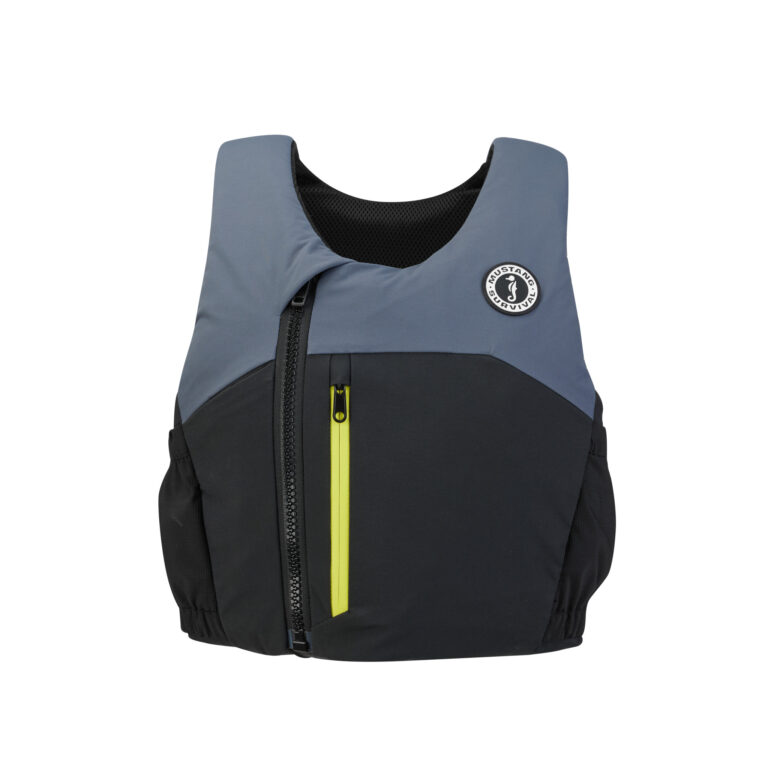
Comfort Rules with Mustang’s Minimalist Buoyancy Aid

Mistakes And Misfires On the Final Day of Cup’s Preliminary Regatta

Emirates Team New Zealand Remain the Bullies of Barcelona

Start-Box Sparring in Barcelona on Day 2 of Preliminary Regatta

- Digital Edition
- Customer Service
- Privacy Policy
- Terms of Use
- Cruising World
- Sailing World
- Salt Water Sportsman
- Sport Fishing
- Wakeboarding
Welcome to Lake
Discover places to stay and unique experiences around the world.
- How It Works
Home - Blog - Parts of a Boat: Understanding the Essentials with Ease
Parts of a Boat: Understanding the Essentials with Ease

David Ciccarelli
August 26, 2024
In this article
Get started.

Embarking on a boating adventure requires more than just a sense of excitement; it demands a solid understanding of the vessel beneath your feet. Whether you’re a seasoned sailor or a curious novice, grasping the fundamental parts of a boat is essential for both safety and enjoyment.
In this article, we break down the key components of a boat in a straightforward and accessible manner. From the hull to the helm and everything in between, you’ll gain the knowledge to confidently identify and understand the various parts that make up these incredible machines.
Boat Anatomy Overview
Let’s dive into the key parts of a boat, focusing on the hull and the deck. These sections are essential for understanding how a boat operates and what makes each type unique.
Understanding the Hull
The hull is the main body of the boat. It’s the part that sits in the water, providing buoyancy. Different types of hull designs include planing, displacement, and semi-displacement.
Planing Hulls: These hulls lift out of the water quickly, reducing drag and enabling faster travel.
Displacement Hulls: These move through the water, offering more stability and smoother rides, especially in rough seas.
A boat’s stability and speed largely depend on its hull type. Larger vessels often have deep V-shaped hulls for better handling in rough waters. The material of the hull can vary from fiberglass to aluminum , each having pros and cons.
The Deck and Its Components
The deck is the flat surface on top of the hull, where you walk and place equipment. Key components here include the bow, stern, and cockpit.
Bow: The front part of the boat. It often has storage compartments or seating areas.
Stern: The back part of the boat. It usually houses the engine if it’s an outboard motor.
Cockpit: The area where you control the boat. It contains the steering wheel, navigation systems, and control panels.
Other important deck parts include the cleats, which secure ropes, and the pulpit, which has a safety rail at the front. Each plays a vital role in the boat’s operation and safety.
Crucial Boat Sections

Bow: The Front End
The bow is the front part of the boat. It’s designed to cut through the water, creating less resistance and helping with smooth navigation. The bow usually has a pointed or rounded shape to achieve better hydrodynamics.
The bow is the first part to meet the water when you’re moving forward . This section also affects the boat’s overall stability and balance. Additionally, many boats have a bowsprit, a pole extending from the bow for attaching sails.
Knowing your bow’s position helps with docking and maneuvering in tight spaces. So, look for it when you’re steering your vessel.
Stern: The Rear End
The stern is the back part of the boat. It’s where you’ll often find the transom, the flat surface at the very end. This area is crucial for mounting the boat’s engine.
When you move aft, you head toward the stern. The stern plays a key role in determining how the boat handles. For instance, a low stern can help with stability in rough waters.
Sometimes, the stern includes a swim platform or ladder for easy access to the water. This part of the boat is especially important if you’re into watersports.
Port Side: Left of the Vessel
The port side is the left side of the boat when you’re facing forward, toward the bow. Mariners use this term to avoid confusion, especially when giving directions.
To help remember, “port” has the same number of letters as “left.” Also, the port side is marked with a red light in the dark to ensure safety and proper navigation at night.
Understanding the port side is essential for proper anchoring and docking. Knowing which side is port helps you communicate better with your crew and other boats when maneuvering.
Starboard Side: Right of the Vessel
The starboard side is the right side of the boat when you’re facing forward. This term helps sailors avoid confusion, especially in emergencies or when coordinating maneuvers.
To remember: “starboard” sounds like “star right.” The starboard side is marked with a green light for nighttime navigation. This ensures everyone on the water knows which direction you’re headed.
Knowing your starboard side helps with many activities, from docking to sailing. It also enhances communication with other boats and your crew, making operations smoother and safer.
Essential Navigation and Control Features
The helm: controlling the boat.
The helm is where you control the boat. It includes the steering wheel or tiller and the rudder, which steers the vessel. It’s usually located in the cockpit or on the flybridge in larger boats, giving you a good view.
Sometimes, the helm also features navigation lights to help you see and be seen at night.
The rudder plays a key role in maneuvering. It’s a flat piece behind the boat that moves back and forth when you turn the wheel or tiller, changing the boat’s direction. Simple, right?
Masts and Sails: The Tools of Sailboats
On a sailboat, the mast stands tall and holds the sails. The sails catch the wind and propel the boat forward. Rigging refers to the ropes and lines that control the sails, including tasks like tacking, which is changing direction with the wind.
The sails come in different types, like the mainsail and the jib. Each has a different role. The mainsail is the big one in the middle, while the jib is smaller and at the front.
Remember, mastering the rigging and sails can greatly affect how smoothly my sailboat glides through the water!
Safety and Mooring Equipment
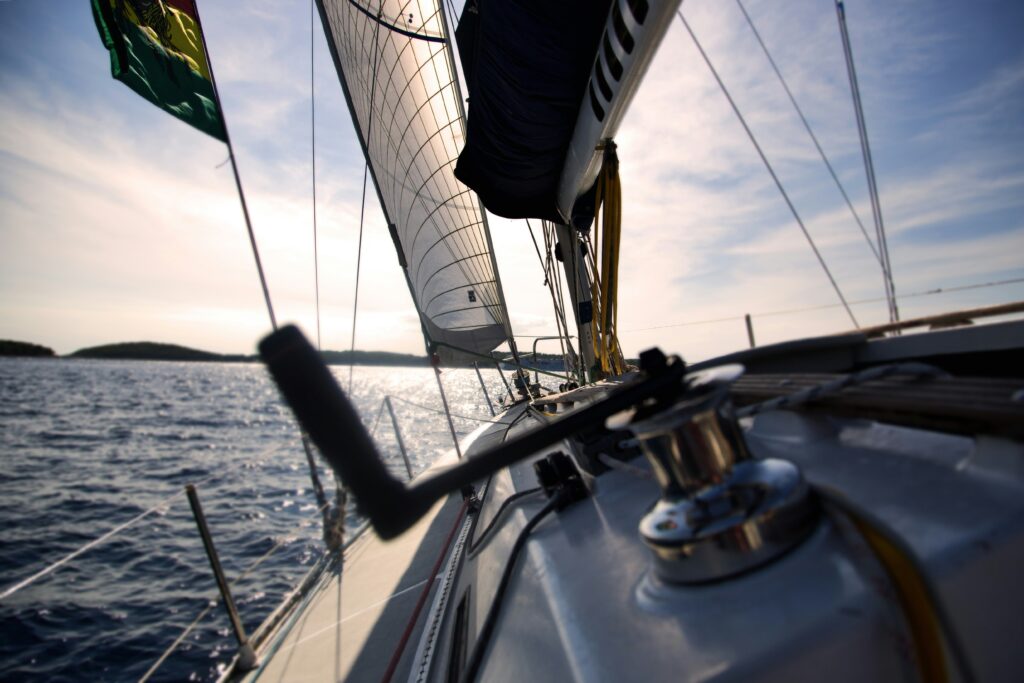
When it comes to boating , ensuring your vessel’s and crew’s safety is crucial. This includes having the right mooring systems and equipment to secure your boat. Let’s take a closer look at some key components.
Anchor and Cleats: Docking and Anchoring Basics
Every boat needs a reliable anchor to keep it in place when not in motion. Anchors come in various types, such as plow, fluke, or mushroom, each suited for different seabeds. But having the right anchor isn’t enough; you also need strong cleats. Cleats are metal fittings on the deck where you tie off your mooring lines.
Properly using cleat hitch knots ensures that your boat is securely tied to the dock. Always make sure the cleats are bolted down well to avoid mishaps. For safety, keep spare mooring lines on hand.
Fenders: Protecting the Vessel
Fenders are crucial for preventing damage to your boat while it’s docked. These are essentially bumpers that absorb shock and prevent scratches or dents. You can find fenders in various shapes and sizes, from cylindrical to round.
The key is to hang them at the correct height to cushion your boat and the dock or other vessels. Regularly check your fenders for wear and tear, and replace them if they show signs of damage. Always have a couple of extra fenders in storage, just in case.
Engine and Propulsion
A boat’s engine and propulsion system are the heart and muscles that drive it through the water. From various types of engines to the way propellers function, these elements work together to ensure smooth sailing.
Propellers: Turning Energy into Motion
A propeller takes the power from the engine and converts it into thrust, moving the boat forward. Whether the engine is an inboard engine housed within the hull or an outboard engine mounted on the stern, the propeller’s role is crucial.
The propeller blades create a difference in water pressure, pulling water in and pushing it backward, propelling the boat forward. The size and shape of the propeller blades impact speed and efficiency.
Engines and propellers have to be well-matched. For example, a big boat needs a larger propeller to push more water. Maintenance is also vital to keep the system in top shape.
In short, without a functioning propeller, your boat isn’t going anywhere.
Supplementary Boat Parts
Knowing about the extra parts that make it even better is important to enjoy a smooth and safe boating experience. We’ll explore components that keep your boat dry and make recreation more fun.
Bilge and Bulkheads: Keeping Water at Bay
The bilge is the lowest part of the boat, where water can collect. Water can seep in from splashes, leaks, or even rain. A bilge pump is used to pump this water out. Without it, you’d be constantly bailing out water like a sailor in old times! I always recommend having a reliable bilge pump.
Bulkheads are vertical partitions that divide the boat into sections. They give the boat structure and help prevent flooding. Imagine one section getting flooded; bulkheads keep the water from spreading. It’s like having watertight walls inside your boat.
You usually find bilge pumps near the bilge, often installed to pump water out when it reaches a certain level automatically. That way, less worry for you. Bulkheads, meanwhile, are positioned at crucial points to ensure your boat remains stable and safe.
Swim Platforms and Casting Decks: Recreation and Sport
Swim platforms are flat surfaces at the back of the boat, just above the waterline. They make it easy to get in and out of the water. If you like swimming or just dangling your feet in the water, you’ll love it. A good platform should be sturdy and slip-resistant.
Casting decks are spaces on the boat designed for fishing . They give you a stable area to cast your line. These decks often come with livewells to keep your catch fresh. Imagine standing on a firm deck and reeling in a big one without losing your balance—that’s what a casting deck is for.
Both swim platforms and casting decks are designed to enhance fun moments on the water, adding both convenience and enjoyment.
Types and Functions of Boats

There are various types of boats, each designed for different purposes and functions. Some are used for recreation, while others are essential for fishing or transportation.
Local Traditions and Various Vessel Functions
Local traditions often influence boat designs. For example, whaleboats are long and narrow. They’re designed for speed and maneuverability to catch whales.
Fishing boats are equipped with fishing rods, nets, and storage for the catch. Sailboats use sails to harness the wind, making them perfect for leisure and competition.
Here’s a quick look at some boat types for different activities:
- Sailboats: Use wind for movement; used for racing or leisure
- Fishing boats: Equipped to catch and store fish
- Whaleboats: Designed for hunting whales
Each type of boat has unique features tailored to its specific function, influenced by local needs and traditions.
Boating Know-How
Knowing the parts of a boat and the terminology used in boating is essential for safe and effective operation. This guide will help you get familiar with key nautical terms.
Language of the Seas: Nautical Terminology
When you start boating, you need to learn the language of the seas. Nautical terminology helps everyone on board communicate clearly and avoid confusion.
- Bow : The front part of the boat.
- Stern : The back part of the boat.
- Port : The left side of the boat when facing forward.
- Starboard : The right side of the boat when facing forward.
Knowing these terms can help a boater direct the crew more effectively. If someone yells, “Man overboard, port side!” you need to know instantly where to look.
Also, understanding basic sailing terms like tacking and jibing is important.
In addition, a boating license often requires passing a test that includes these terms. So, mastering them isn’t just about being safe—it’s also about being legally compliant.
Study these terms thoroughly before hitting the water. They’ll make your boating experience smoother and safer.
Frequently Asked Questions
What do you call the front section of a boat.
The front of a boat is called the bow. It’s the part that cuts through the water first as you sail. Simple, right?
Can you list the main structural components of a boat?
Sure! Boats have several main parts:
- Hull : The body of the boat
- Deck : The flat surface on top of the hull
- Engine : Powers the boat
- Sails : Used on sailboats to catch the wind
What’s the term for the back end of a boat?
The stern is the back end of a boat . It often influences the boat’s stability and handling.
What are the different sides of a boat known as?
There are specific terms for the sides of a boat:
- Port : The left side when you’re facing forward
- Starboard : The right side when you’re facing forward
Could you name some parts unique to a fishing boat?
Fishing boats have unique parts, such as:
- Livewell : A tank for keeping fish alive
- Rod holders : For securing fishing rods
- Outriggers : Extendable poles for trolling
What common features are found on a yacht?
Yachts often come with luxurious features:
- Cabin : Enclosed space for sleeping and living
- Galley : Boat’s kitchen
- Flybridge : An upper deck with a steering station

administrator
David Ciccarelli, is the Founder and CEO of Lake. He is based in Toronto, Canada, and is an expert in management, business administration, strategy, product development, and customer experience. His educational achievements include the Owner President Management Program at Harvard Business School (2019-2022) and the QuantumShift Program at Ivey Business School in 2017, aimed at CEOs of growing businesses.
- Parts of a Boat
Related Posts

August 18, 2024
Boating: Your 10-Step Guide to Driving a Boat Safely
Boating is one of the most exhilarating ways to embrace […]

Water Skiing Essentials: Tips and Tricks for a Thrilling Experience
Water skiing is an exhilarating surface water sport where individuals […]
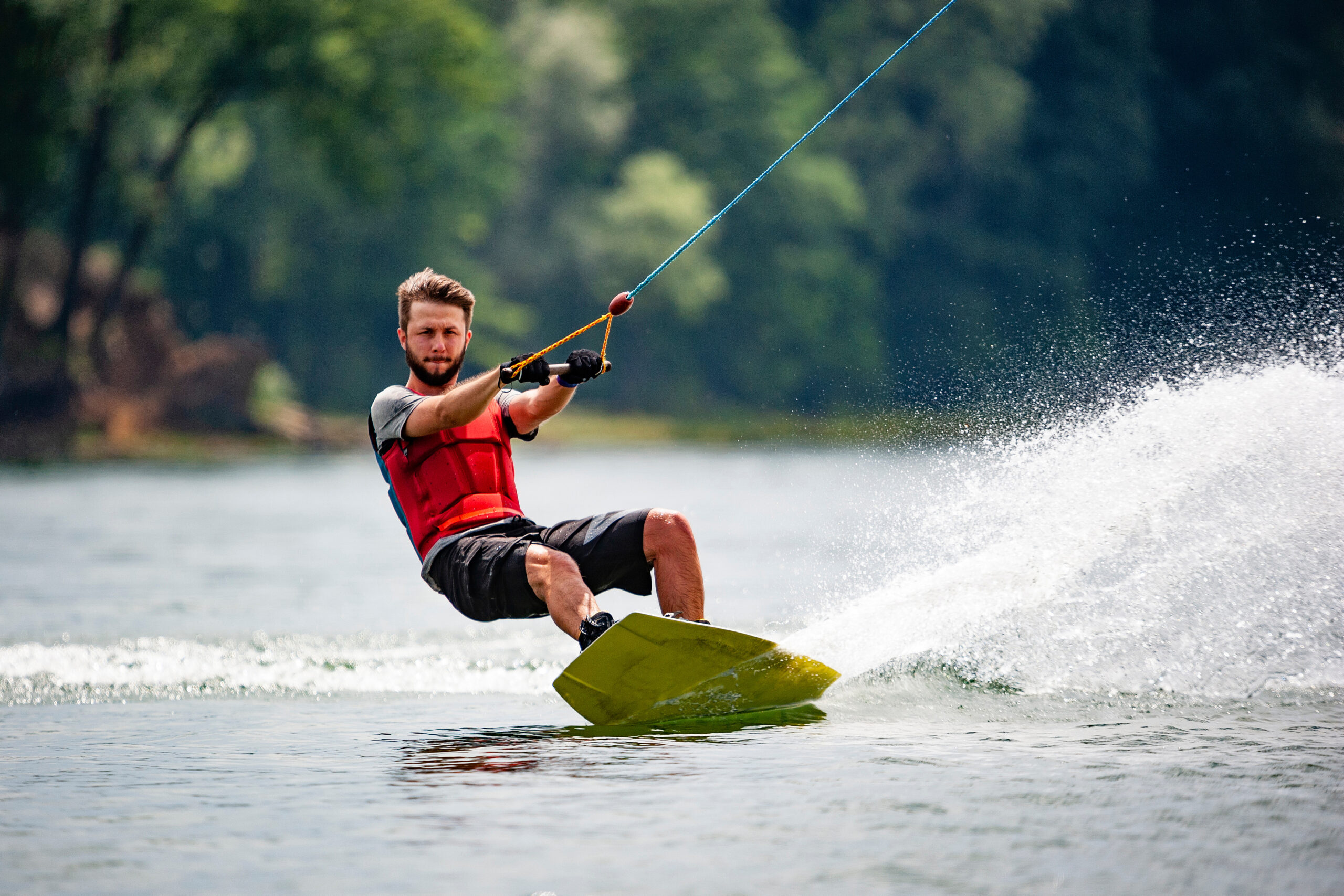
May 31, 2024
Wakeboarding Fun: Tips and Techniques for Every Skill Level
Wakeboarding Tips and Techniques, For Beginners and Pros Wakeboarding is […]
Don't have an account yet? Register
Already have an account? Sign In
Reset Password
Please enter your username or email address, you will receive a link to create a new password via email.

- Join Newsletter
Our Promise to you
Founded in 2002, our company has been a trusted resource for readers seeking informative and engaging content. Our dedication to quality remains unwavering—and will never change. We follow a strict editorial policy , ensuring that our content is authored by highly qualified professionals and edited by subject matter experts. This guarantees that everything we publish is objective, accurate, and trustworthy.
Over the years, we've refined our approach to cover a wide range of topics, providing readers with reliable and practical advice to enhance their knowledge and skills. That's why millions of readers turn to us each year. Join us in celebrating the joy of learning, guided by standards you can trust.
What is a Whisker Pole?
A whisker pole is a form of spar that is used to help hold the clew portion of the jib when the vessel is sailing off the wind current. These poles belong to a part of basic sailboat and yacht configuration that is known as a spar. Essentially, a spar is a round piece of timber or metal that is part of the basic outfitting of a sailing vessel. Along with the whisker pole, other types of spars include the masts, gaffs, yards, and booms found on the boat. Each of these different types of spars play a role in securing sails into position, so the boat can be directed in any direction desired, using air flow as the force for the movement. The whisker pole is perhaps the lightest of all the different types of spars that are in use as part of standard equipment on a sailing vessel.
Whisker poles themselves are also constructed using hardwood that has been sealed against moisture and humidity. Some versions are constructed using steel and similar hard metals. Like their wooden counterparts, the metal poles will be treated and sealed, so that the material will withstand corrosion from the elements. Held in place with a series of bolts, it is not unusual for a spare pole to be stowed somewhere on the sailing vessel, in the event that any type of damage does occur during the voyage.

The main function of the whisker pole has to do with the proper securing and operation of the jib sail. As a triangular shaped sail, the jib helps to control the speed and direction of the sailboat or yacht during sailing. The whisker pole provides a connection between the main mast and the front section of the vessel, allowing the jib sail to be fully unfurled for use in catching the wind.

The dimensions of the whisker pole are fairly standard, so there is no problem in obtaining the right length for most sailing vessels. Marinas usually keep a number of different sizes in stock, so replacements are readily available when needed. Also, most shipbuilding companies will also manufacture a line of whisker pole types that are custom designed for the sailboats they build and sell.
Editors' Picks

Related Articles
- What Is Boom Brake?
- What is a Boom Vang?
- What is a Lock Pit®?
- What is Spar Varnish?
- What is a Gaff?
- What is a Halyard?
- What is a Helmsman?

Our latest articles, guides, and more, delivered daily.
- Search Please fill out this field.
- Newsletters
- Water Sports
Learn the Parts of a Sailboat and How to Communicate Them
Essential Words You Need to Know
Pierre-Yves Babelon/Getty Images
The following are terms related to sailboats and their equipment , including the parts of the boat and how to communicate on one. Enjoy our list of all things nautical.
- Auxiliary - A sailboat's engine, or a sailboat with an engine
- Backstay - The cable, usually made of wire, running from the stern to the masthead that helps support the mast
- Ballast - The weight in a sailboat's keel (sometimes in a centerboard) that helps keep the boat from leaning too much
- Batten - A slat, typically made of plastic, placed in a pocket in the mainsail to help it maintain good shape
- Beam - The width of the boat at its widest point
- Bitter end - The free end of a line
- Block - A pulley-like device used on a boat, with a sheave around which a line runs
- Boom - The spar, which is usually horizontal, back from the mast to which the foot of a sail is attached
- Boom vang - A device that prevents the boom from rising and, in some types, lowering
- Bow - The front section of the boat
- Cat rig - A sailboat designed for using a mainsail only, with the mast usually located more forward than in a sloop
- Centerboard - A thin, keel-like structure that can be raised (usually rotated on a hinge up into a centerboard trunk in the hull) that's present on many sailboats without a fixed keel to prevent the boat from being blown sideways
- Chock - A type of fairlead fitting through which an anchor rode or dock line passes to reduce chafing
- Cleat - A fitting around which a line is secured
- Companionway - The entrance area and steps from the cockpit into a sailboat's cabin
- Clew - The lower rear corner of a sail
- Daggerboard - Like a centerboard, but raised and lowered vertically instead of rotating on a hinge
- Daysailer - Generally a small sailboat without a cabin large enough for comfortable overnight cruising
- Dinghy - A type of small sailboat or a small row or powered craft typically taken along when cruising in a larger sailboat
- Displacement - The weight of a boat, equal to the weight of water the boat displaces
- Dodger - A spray shield often made of foldable or removable fabric at the front of the cockpit
- Draft - The distance from a boat's waterline to the lowest part of its keel
- Fender - A bumper generally made of rubber hung alongside the boat to prevent the hull from rubbing against a dock or other structure
- Foot - The bottom edge of a sail (compare to leach and luff, below)
- Forestay - A cable usually made of wire running from the bow to the masthead that helps support the mast
- Forward - Toward the bow
- Freeboard - The height of the deck above the water (the topsides section of the hull)
- Gate - An opening in the lifelines for boarding the boat, also called gangway
- Genoa - A large jib sail (the clew extends aft of the mast)
- Gooseneck - The fitting that attaches the boom to the mast
- Ground tackle - The collective term for a boat's anchor and anchor rode
- Gunwale (sometimes gunnel) - The outer edge of the boat's deck and cockpit, also called the rail
- Halyard - Line or wire used to hoist a sail
- Hank on - To attach a jib sail to the forestay with small snap hooks called hanks
- Head - The bathroom of a boat and also the top corner of a sail
- Helm - The means by which the sailboat is steered: the tiller or wheel
- Jackline - A line, strap, or wire secured over the deck as an attachment point for the tether of a safety harness
- Jib - The triangular sail attached to the forestay
- Keel - The lower section of a sailboat's hull that's usually permanent and counteracts sideways movement and typically contains ballast
- Ketch - A type of sailboat with two masts
- Lanyard - A short cord or line, often used to secure a piece of gear (knife, whistle, etc.) that might be dropped
- Leech - The back edge of a jib or mainsail (compare to foot and luff, above and below)
- Lifeline - A line or wire (often vinyl coated) all around the boat that's held up with stanchions to prevent falling overboard
- Line - Any piece of rope used on a boat
- Luff - The leading edge of a jib or mainsail (compare to foot and leech, above)
- Mainmast - The mast, or the tallest mast of a sailboat with multiple masts
- Mainsail - The sail affixed to and behind the mainmast
- Mast - A tall vertical pole on a sailboat to support sails and rigging
- Mast step - The support structure for the bottom of the mast
- Mizzen - The smaller aft mast on a ketch or yawl; the mizzensail is affixed to and behind the mizzenmast
- Multihull - A catamaran (two hulls) or trimaran (three hulls)
- Outhaul - A fitting to adjust the tension of the foot of the mainsail on the boom
- Padeye - A fitting usually made of metal with a loop or hoop to which other gear is attached
- Pendant (sometimes pennant) - A short line attaching the bow of a boat to a mooring, or a short wire attached to a sail or halyard as an extension
- PFD - A personal flotation device such as a lifejacket or an inflatable PFD
- Port - The left side of the boat when facing forward; the opposite of starboard
- Preventer - A-Line or other device used to prevent the boom from accidentally swinging from one side to the other
- Pulpit - A rail generally made of stainless steel around the bow or stern typically at the height of the lifelines
- Rail - the outer edge of the boat's deck and cockpit; also called the gunwale
- Rig (or rigging) - The mast, boom, and associated equipment including stays, shrouds, sheets, and halyards
- Rode - The line or chain between an anchor and the boat
- Roller furler - A device by which a sail is rolled up, such as the jib rolling around a rotating forestay fitting
- Rudder - An appendage below or on the boat's stern that is rotated by moving the tiller or wheel to steer the boat
- Safety harness - Personal gear, either a separate harness or one built into a PFD, that attaches to a tether to keep the person on board
- Sail ties - Short straps or pieces of line used to tie a lowered mainsail to the boom or secure a sail on deck
- Schooner - A type of sailboat with two or more masts, the forward one being shorter than the main mast
- Seacock - A valve fitting for closing an opening through the boat's hull (drains, water pipes, etc.)
- Shackle - A fitting typically made of metal that secures two things together, such as a halyard shackle connecting to a sail
- Sheet - The line used to let out or trim in a sail; on a sloop, a mainsheet and two jib sheets
- Shroud - Wire or line stay from the deck or hull supporting the mast on each side
- Sloop - A type of sailboat with one mast and two triangular sails (main and jib)
- Sole - The floor of the cockpit or cabin
- Spinnaker - A lightweight sail used downwind, often ballooning in front of the boat
- Spreaders - Metal struts on the mast that hold the shrouds out from the mast for a better support angle
- Stanchions - Short metal poles around the boat's perimeter that support the lifelines
- Starboard - The right side of the boat (when facing forward); opposite of port
- Stay - Wire or line from the deck or hull to support the mast; stays include the forestay, backstay, and shrouds (on the sides)
- Tack - The bottom front corner of a sail
- Telltales - Pieces of yarn or ribbons on the luff of a sail to help with trimming, or fastened to shrouds to show the wind direction
- Tether - A short line or strap that runs between a safety harness and a point of attachment on the boat to prevent going overboard
- Tiller - A long handle connected to the rudder or rudder post on many sailboats for steering
- Topping lift - A wire or line from the masthead that holds up the boom when the sail is lowered
- Topsides - The area of outer hull above the waterline
- Traveler - A fitting allowing the mainsheet attachment to the boat to be adjusted side to side
- Vang - See Boom vang
- Whisker pole - A pole used to hold out the jib when sailing off the wind
- Winch - A drum-like device used to pull in lines under strain (halyards, sheets)
- Windless - A heavy winch used with the anchor rode
- Yawl - A type of sailboat with two masts, the aft one (mizzen) being behind the rudder post
Related Articles
More related articles.
Pole used for extending a sail NYT Crossword Clue
Pole used for extending a sail Crossword Clue Answers are listed below. Did you came up with a solution that did not solve the clue? No worries we keep a close eye on all the clues and update them regularly with the correct answers.
POLE USED FOR EXTENDING A SAIL NYT
Leave a Comment Cancel Reply
Your email address will not be published. Required fields are marked *

IMAGES
VIDEO
COMMENTS
The mast is the pole on a sailboat that holds the sails. Sailboats can have one or multiple masts, depending on the mast configuration. Most sailboats have only one or two masts. Three masts or more is less common. Boom. The boom is the horizontal pole on the mast, that holds the mainsail in place. Sails
A sail, which is a large piece of fabric that is attached to a long pole called the mast, uses the wind to pull a sailboat across the water. It has various parts, such as the head, tack, clew, luff, leech, foot, mainsail, jib, and batten. These components determine the shape and efficiency of the sail.
The mast of a sailboat is a tall vertical pole that supports the sails. Larger ships often have multiple masts. The different types of masts are as follows: (1) The Foremast — This is the first mast near the bow (front) of the boat, and it is the mast that is before the mainmast.
The mast is the long vertical spar that extends upward from the deck of a sailboat and holds the sails. It is the tallest part of the boat and is typically made of wood, aluminum, or carbon fiber. ... "Spar" is a general term for a pole made of a solid material like wood, metal, or composite and is used to support a boat's sail. The mast ...
The Whisker Pole is a vital tool for sailors engaging in downwind sailing. This adjustable pole attaches to the mast and the jib/genoa, holding the sail out to catch the wind more effectively. Whisker Pole vs. Spinnaker Pole: Decoding the Difference. It's easy to confuse the Whisker Pole with the Spinnaker Pole, but they serve distinct purposes.
How We Rig the Whisker Pole On Our Boat. 1. Check the integrity and functionality of the pole and its pull line (the line that runs the length of the pole and is used to open the mouth of the pole from afar). Look to make sure there are no major chafe points in the line, or areas where the line looks like it might break).
Mainsail: It's all in the name; this is the boat's mainsail. It is the sail attached to the back of the mast. Mast: The mast is a large, vertical pole that holds the sails up. Some boats have more than one mast. Painter: This is a line positioned at the front of small boats. It is used to tie the boat to a dock or another boat.
If you are sailing downwind, you can greatly improve both your speed and control by using a whisker pole. In this Part 1 video, I walk you through why a whis...
This helps hold the pole down and keep the pole near the clew of the headsail. Figure 4 - Whisker Pole Rigging. Attaching the sail. On some racing boats like Stars, the whisker pole is a spike that goes into the clew ring. This is found on small boats, but most keelboats will have a latching end that you clip over the working (loaded) jib sheet.
Whisker poles are used to "wing out" the jib when sailing downwind. Sailors who have experienced downwind sailing without one can appreciate the value of being able to stabilize the jib, enabling the sail to work more efficiently and without the noise of the sail flopping in the wind and waves. Forespar* manufactures the finest and most ...
Sailboats require four main parts to operate: a hull, mast, sail, and rudder. The hull is the body of the boat, and all other parts are directly or indirectly connected to it. The mast is a long pole that serves as a guide and mounting point for the sail. The sail catches the wind and propels the boat, and the rudder directs the boat and acts ...
A sailboat mast is a vertical pole or spar that supports the sails of a sailboat. It provides structural stability and allows for adjustment of the sail position to effectively harness wind power. Typically made of aluminum or carbon fiber, mast design varies based on boat size, sailing conditions, and intended use.
Mainsail: As the name implies, this is the main sail of the boat. It is the sail attached to the back of the mast. Mast: The mast is a large, vertical pole that holds the sails up. Some boats have more than one mast. Painter: This is a line positioned at the front of small boats. It is used to tie the boat to a dock or another boat.
1. Mast - A durable vertical pole, which is one of the main structural components of a sailboat, that holds up the sails, provides stability and gives the sailboat its height. 2. Jib Head - The top area of the jib that includes a ringhole to allow connection to the jib halyard which attaches to the top of the mast. 3.
routinely use the pole in heavy weather or offshore sailing, you may want to consider going up to a larger diameter pole for additional strength. Size and Strength of Crew Like almost everything on a sailboat, deploying a Whisker Pole involves skill and practice because you need to get on the foredeck to connect the pole to the headsail.
A sailboat is a boat that is propelled either partly or entirely by sails. Sailing is popular in many destinations around the world. For example, Bahamas catamaran charters are a time-honored tradition in the Caribbean, and in the Mediterranean, sailing is a way of life. There are several different types of sailboats and what constitutes a sailboat varies by maritime culture and region.
When a boat is no more possible to be transferred by another it is called a ship. BOAT HOOK - A pole with a hook. You use it to grab and pick up a rope, collect something that has fallen overboard, or push the vessel off the port. BOOM - A horizontally set pole that holds the bottom of the sail. Not a pleasant experience having this hit you ...
First, ease the foreguy (or take the leeward sheet off the bow cleat), and tum the boat down slightly as you did on the initial set. This allows the bowman to get the pole off the mast without a ...
Masts and Sails: The Tools of Sailboats. On a sailboat, the mast stands tall and holds the sails. The sails catch the wind and propel the boat forward. Rigging refers to the ropes and lines that control the sails, including tasks like tacking, which is changing direction with the wind. The sails come in different types, like the mainsail and ...
By. Malcolm Tatum. Updated: May 23, 2024. Views: 29,871. A whisker pole is a form of spar that is used to help hold the clew portion of the jib when the vessel is sailing off the wind current. These poles belong to a part of basic sailboat and yacht configuration that is known as a spar. Essentially, a spar is a round piece of timber or metal ...
Whisker pole - A pole used to hold out the jib when sailing off the wind; Winch - A drum-like device used to pull in lines under strain (halyards, sheets) Windless - A heavy winch used with the anchor rode; Yawl - A type of sailboat with two masts, the aft one (mizzen) being behind the rudder post
The Crossword Solver found 30 answers to "pole that holds a sail", 4 letters crossword clue. The Crossword Solver finds answers to classic crosswords and cryptic crossword puzzles. Enter the length or pattern for better results. Click the answer to find similar crossword clues . Enter a Crossword Clue. A clue is required.
About This Product. The COLOURTREE 12 ft. Stainless Steel Pole and Kit provides an easy-to-install and sturdy attachment point for your shade sail when you lack the means of securing a corner (no tree, wall, etc.). Forget your typical 4 in. x 6 in., there is no more need to tirelessly dig holes and set concrete to have long-lasting stability.
When facing difficulties with puzzles or our website in general, feel free to drop us a message at the contact page. February 17, 2024 answer of Pole Used For Extending A Sail clue in NYT Crossword Puzzle. There is One Answer total, Sprit is the most recent and it has 5 letters.